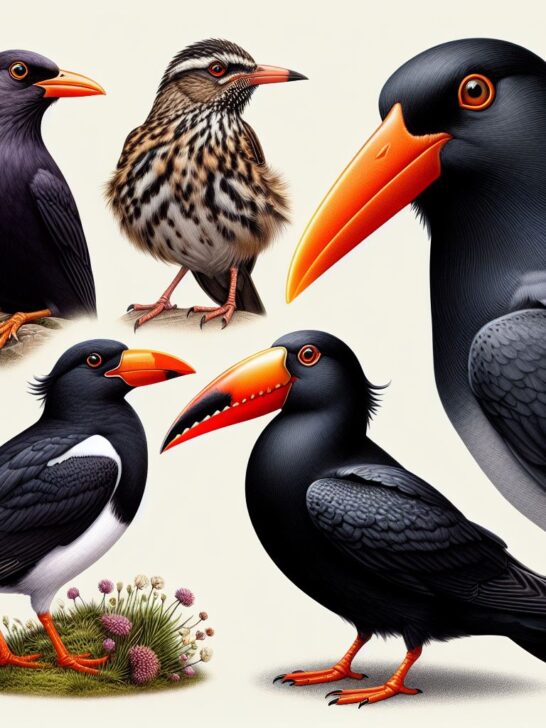Birds with black plumage and orange beaks are among the most striking and captivating species in the avian world. From seabirds to songbirds, raptors to waterfowl, these birds exhibit a remarkable diversity of forms and behaviors, each adapted to thrive in its own unique habitat. Whether diving for fish in coastal waters, foraging for insects in dense forests, or soaring high above the treetops, these birds inspire awe and wonder in all who observe them.
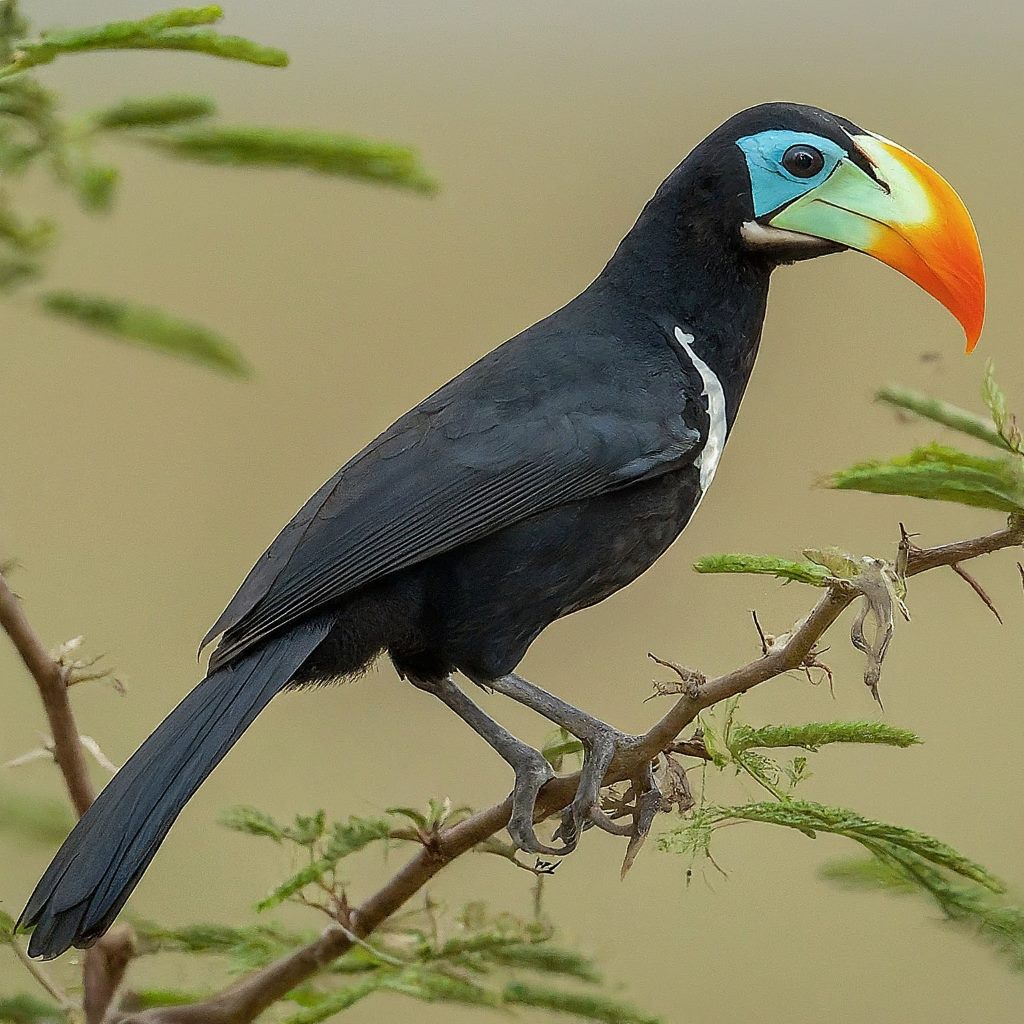
Post Contents
- Abyssinian Scimitarbill
- African Pied Wagtail
- African Skimmer
- Oystercatcher’s
- Atlantic Puffin
- Bateleur
- Black And Gold Cotinga
- Black Heron
- Black Laughing thrush
- Black Oropendola
- Black Scoter
- Black Skimmer
- Black breasted Thrush
- Chestnut headed Oropendola
- Common Black Hawk
- Common Blackbird
- Common Hill Myna
- Crested Auklet
- Crested Caracara
- Crowned Hornbill
- Rhinoceros Hornbill
- Dusky Lory
- Eurasian Blackbird
- Golden Crested Myna
- Gray winged Blackbird
- Great Cormorant
- Greylag Goose
- Inca Tern
- Indian Blackbird
- Javan Myna
- Keel billed Toucan
- Montezuma Oropendola
- Orange billed Sparrow
- Red billed Buffalo Weaver
- Red crested Wood Partridge
- Regent Bowerbird
- Scarlet rumped Cacique
- Yellow rumped Cacique
- Seychelles Bulbul
- Snail Kite
- Surf Scoter
- Toco Toucan
- Tufted Puffin
- Violet Turaco
- Wattled Curassow
- Conclusion
Abyssinian Scimitarbill
The Abyssinian Scimitarbill (Rhinopomastus minor) is a striking bird found in eastern Africa, particularly in Ethiopia, Somalia, and Kenya. It belongs to the family Phoeniculidae and is characterized by its sleek black plumage and distinctive curved orange beak. The beak is long and slender, with a downward curve resembling a scimitar, hence the name “Scimitarbill.” This bird inhabits dry savannas and scrublands, where it feeds primarily on insects, including grasshoppers, beetles, and termites, using its sharp beak to probe into crevices and extract prey. The Abyssinian Scimitarbill is known for its acrobatic flight and melodious calls, making it a delightful sight and sound in its natural habitat.
African Pied Wagtail
The African Pied Wagtail (Motacilla aguimp) is a small passerine bird found throughout sub-Saharan Africa, from Senegal to Ethiopia and south to South Africa. It belongs to the family Motacillidae and is characterized by its distinctive black and white plumage and bright orange beak. The African Pied Wagtail is often found near water bodies, including rivers, lakes, and wetlands, where it feeds on insects, crustaceans, and small fish. Its wagging tail and lively movements make it easy to spot as it forages for food along the water’s edge. This adaptable bird is also commonly found in urban areas, where it frequents parks, gardens, and even city streets.
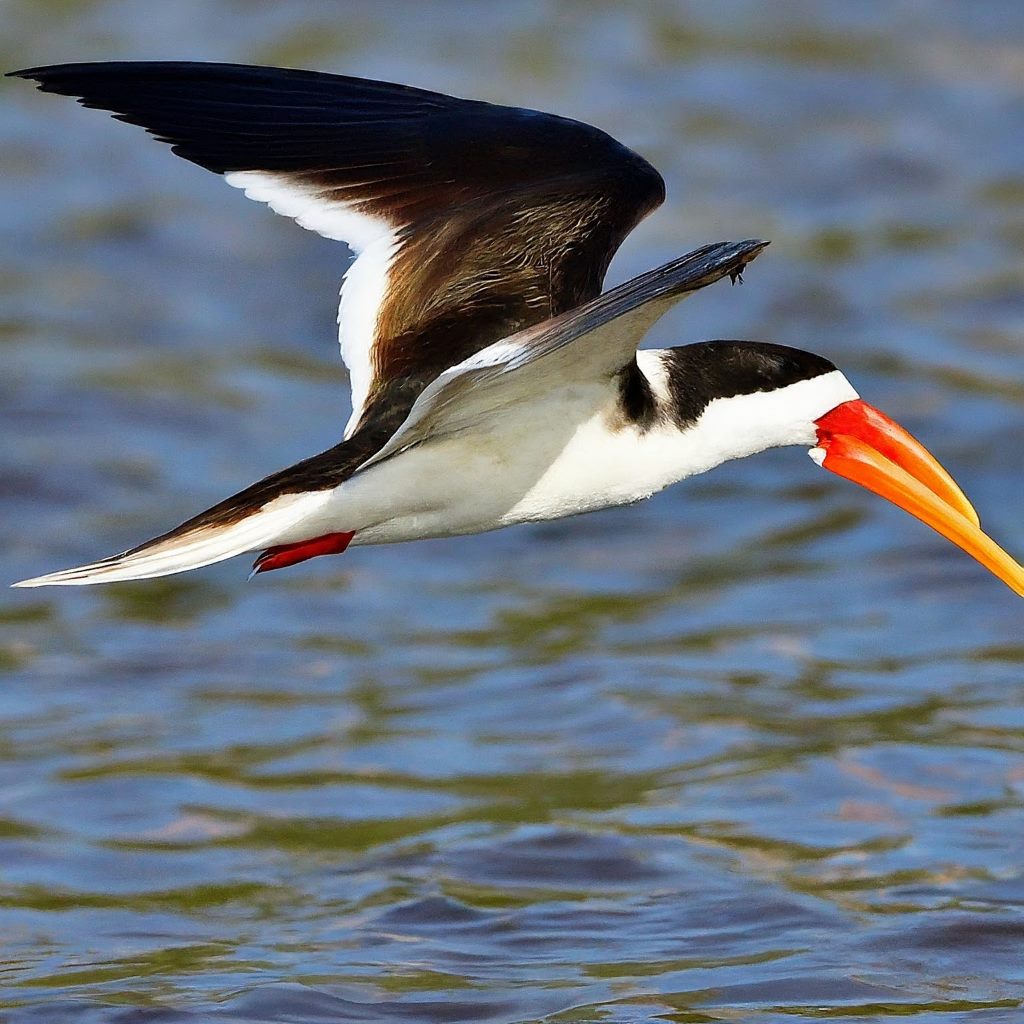
African Skimmer
The African Skimmer (Rynchops flavirostris) is a unique bird found in sub-Saharan Africa, particularly in the river systems and coastal areas of eastern and southern Africa. It belongs to the family Rynchopidae and is characterized by its striking black and white plumage and distinctive orange bill with a yellow tip. The African Skimmer has a specialized feeding technique where it flies low over the water’s surface with its lower mandible submerged, skimming the water for small fish and aquatic invertebrates. Its serrated bill allows it to catch prey with precision as it glides effortlessly over rivers and estuaries. The African Skimmer is highly social and often forms large colonies during the breeding season, nesting on sandbanks and gravel bars along riverbanks.
Oystercatcher’s
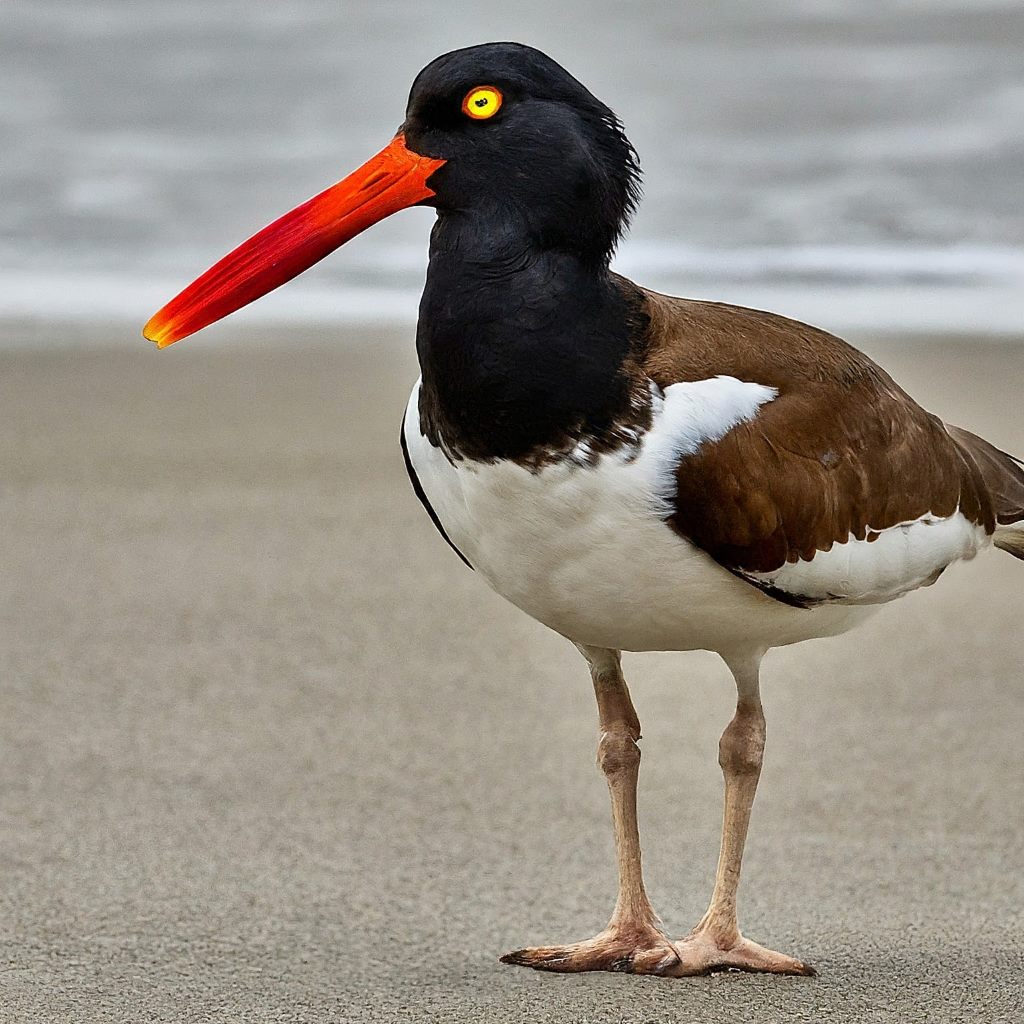
American Oystercatcher
The American Oystercatcher (Haematopus palliatus) is a coastal bird found along the Atlantic and Gulf coasts of North and South America, from the northeastern United States to northern Brazil. It belongs to the family Haematopodidae and is characterized by its black and white plumage and distinctive long orange bill. The American Oystercatcher is often found on sandy beaches, mudflats, and rocky shorelines, where it feeds on bivalve mollusks such as oysters, clams, and mussels. Its powerful bill is used to pry open shellfish and extract the meat inside, making it an important species in coastal ecosystems. American Oystercatchers are known for their loud, piping calls and striking courtship displays, which involve aerial acrobatics and ritualized behaviors.
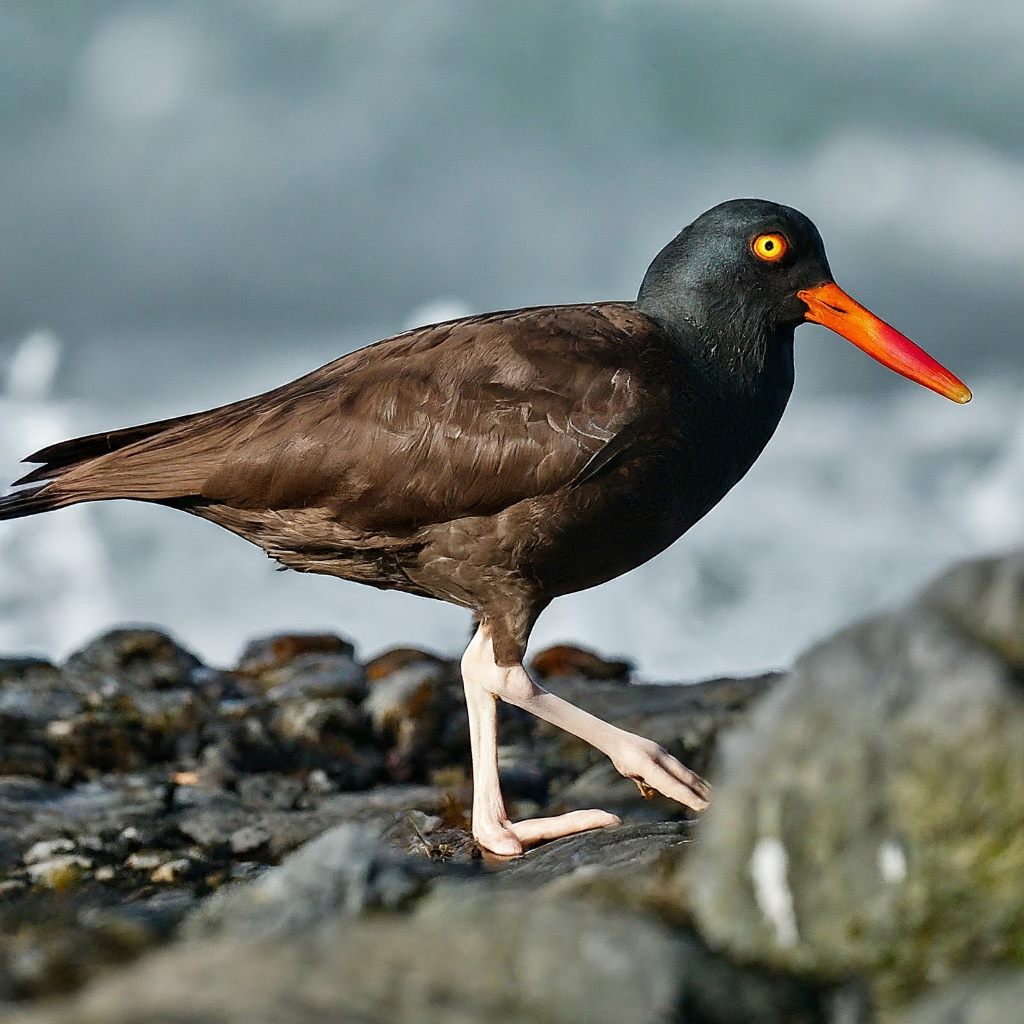
African Black Oystercatcher
The African Black Oystercatcher (Haematopus moquini) is a coastal bird endemic to southern Africa, particularly along the rocky shores of South Africa and Namibia. It belongs to the family Haematopodidae and is characterized by its entirely black plumage and bright orange bill. The bill is long and stout, ideal for prying open shellfish and probing into rocky crevices in search of prey. African Black Oystercatchers feed primarily on mollusks, crustaceans, and other intertidal creatures found along the shoreline. They are monogamous birds and form long-term pair bonds, often returning to the same breeding sites year after year to raise their chicks.
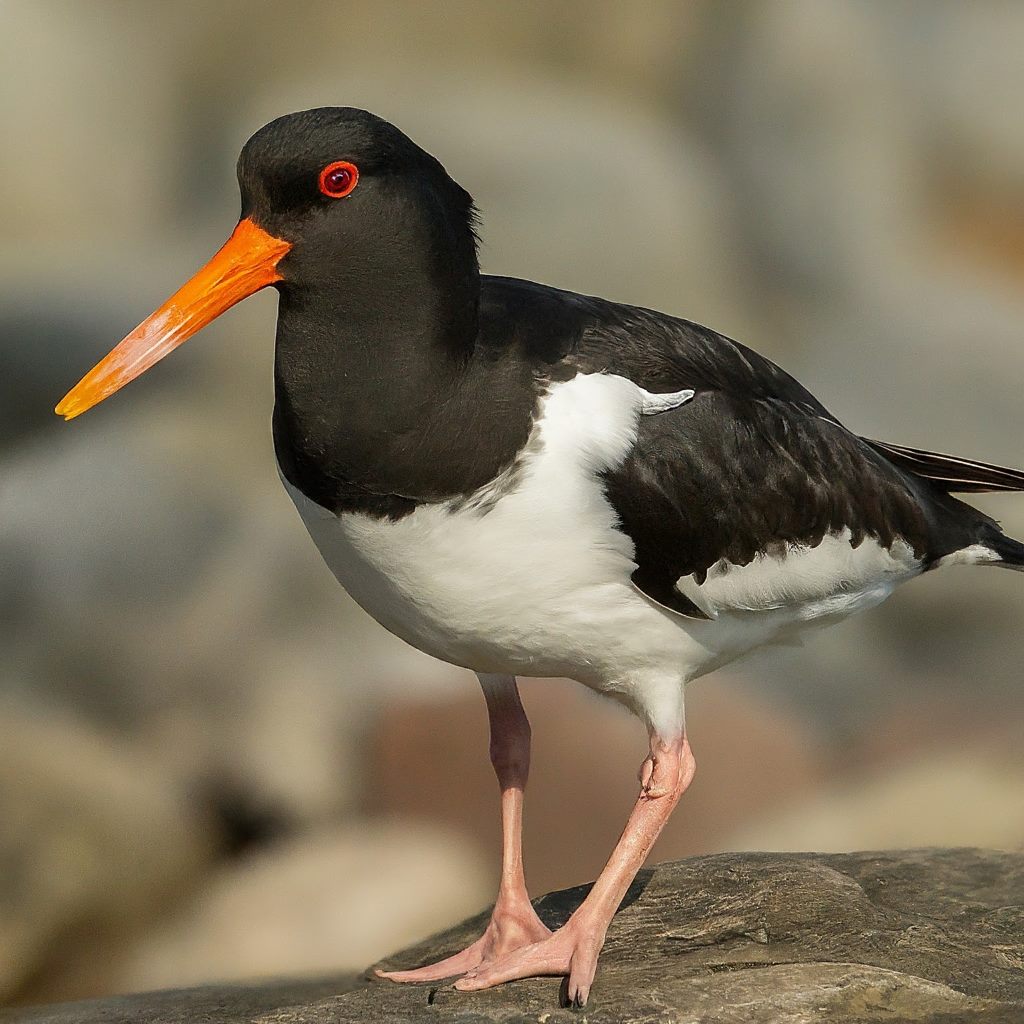
Eurasian Oystercatcher
The Eurasian Oystercatcher (Haematopus ostralegus) is a coastal bird found along the shores of Europe, Asia, and Africa. It belongs to the family Haematopodidae and is characterized by its black and white plumage, bright orange bill, and distinctive long red legs. The Eurasian Oystercatcher is often found on sandy beaches, mudflats, and rocky shorelines, where it feeds on bivalve mollusks such as oysters, clams, and mussels. Its powerful bill is used to pry open shellfish and extract the meat inside, making it an important species in coastal ecosystems. Eurasian Oystercatchers are monogamous birds and form long-term pair bonds, often returning to the same breeding sites year after year to raise their chicks.
South Island Pied Oystercatcher
The South Island Pied Oystercatcher (Haematopus finschi) is a coastal bird found along the shores of New Zealand’s South Island, particularly in rocky coastal habitats and sandy beaches. It belongs to the family Haematopodidae and is characterized by its black and white plumage, bright orange bill, and distinctive red eye-ring. The South Island Pied Oystercatcher is often found foraging in intertidal zones, where it feeds on bivalve mollusks such as oysters, clams, and mussels. Its powerful bill is used to pry open shellfish and extract the meat inside, making it an important species in coastal ecosystems. South Island Pied Oystercatchers are monogamous birds and form long-term pair bonds, often returning to the same breeding sites year after year to raise their chicks.
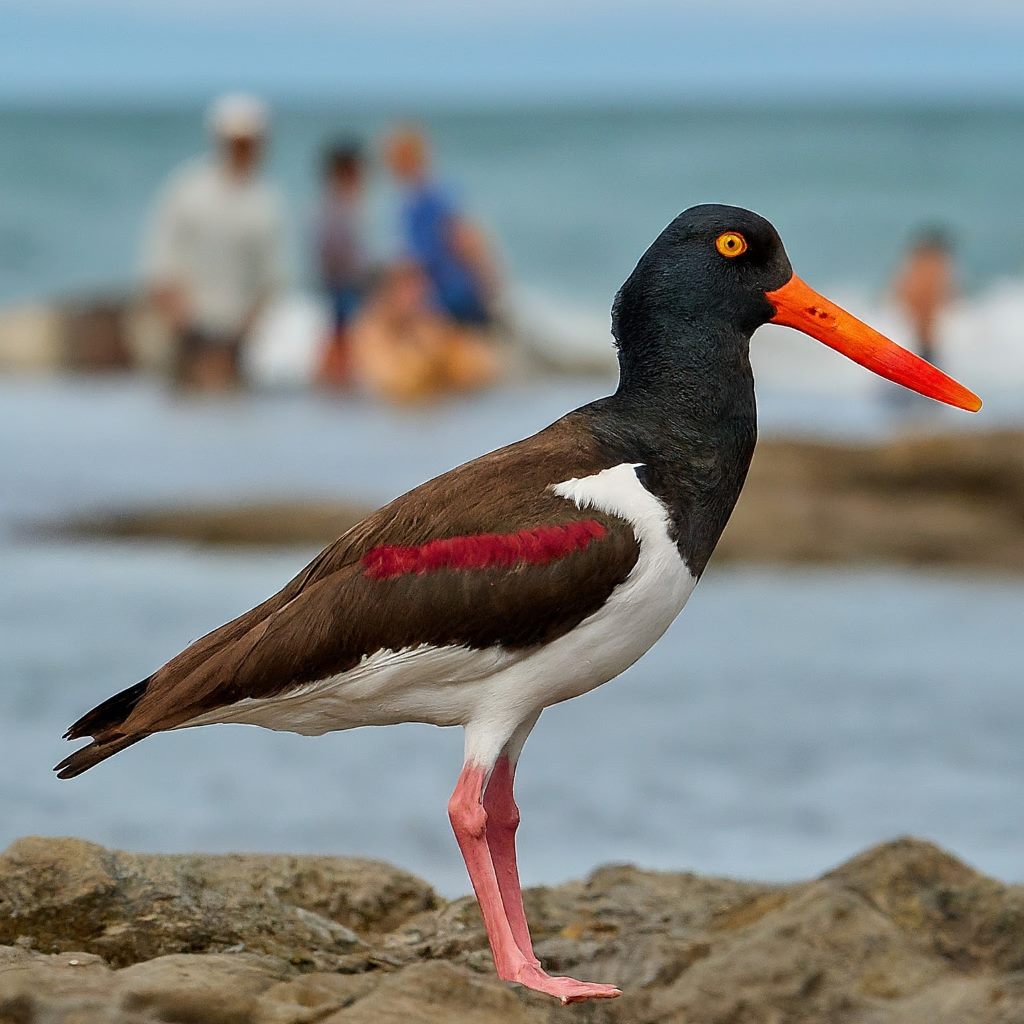
Saddle Oystercatcher
The Saddle Oystercatcher (Haematopus finschi) is a coastal bird found along the shores of New Zealand, particularly in rocky coastal habitats and sandy beaches. It belongs to the family Haematopodidae and is characterized by its black and white plumage, bright orange bill, and distinctive red eye-ring. The Saddle Oystercatcher is often found foraging in intertidal zones, where it feeds on bivalve mollusks such as oysters, clams, and mussels. Its powerful bill is used to pry open shellfish and extract the meat inside, making it an important species in coastal ecosystems. Saddle Oystercatchers are monogamous birds and form long-term pair bonds, often returning to the same breeding sites year after year to raise their chicks.
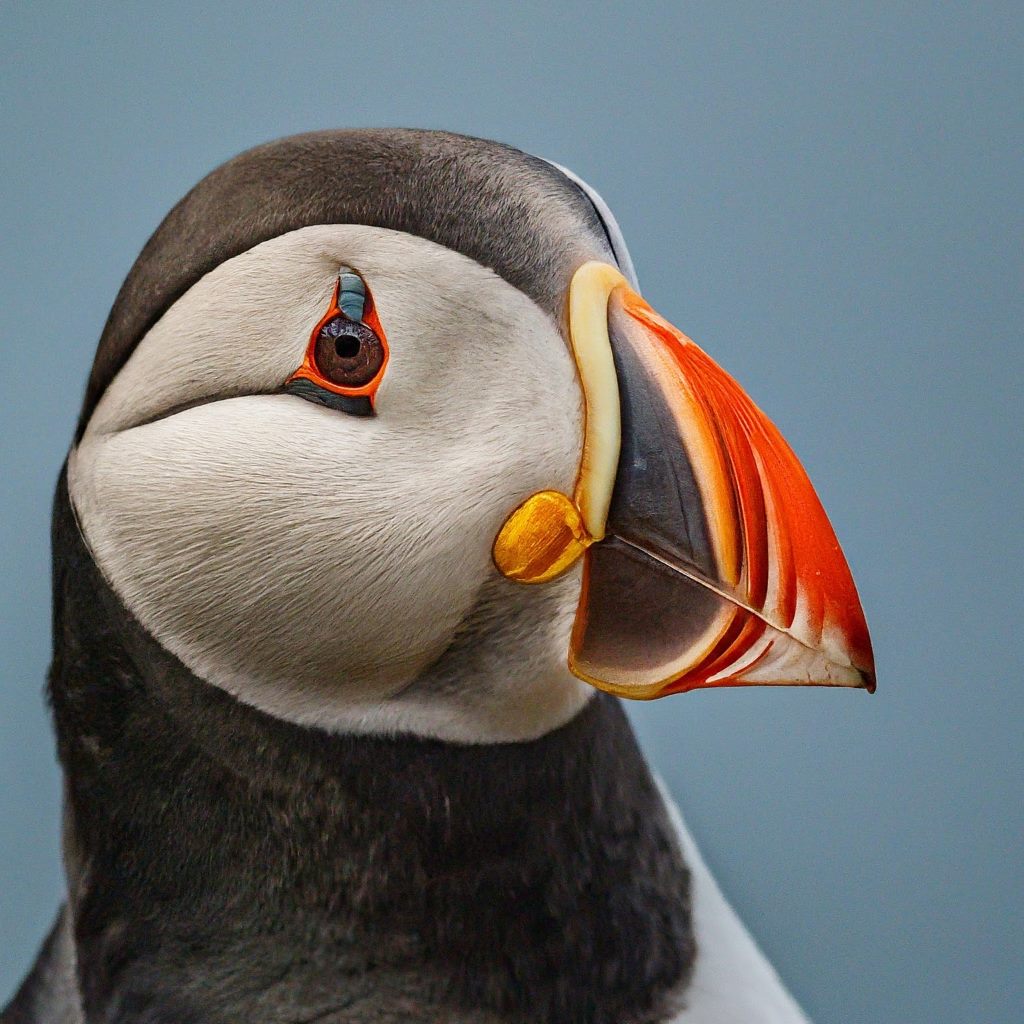
Atlantic Puffin
The Atlantic Puffin (Fratercula arctica) is a charming seabird found in the North Atlantic Ocean, particularly in the coastal regions of northern Europe and North America. It belongs to the family Alcidae and is characterized by its distinctive black and white plumage, colorful beak, and comical appearance. The Atlantic Puffin has a striking orange bill with a yellow and blue base, which becomes brighter during the breeding season. Puffins are skilled divers and feed primarily on fish, crustaceans, and squid caught by plunge-diving from the air. They are also known for their burrow-nesting behavior, where they excavate nesting tunnels in steep cliffs or rocky islands, returning to the same breeding colonies year after year. The Atlantic Puffin is a beloved symbol of coastal wildlife and is often associated with conservation efforts to protect its breeding sites and marine habitats.
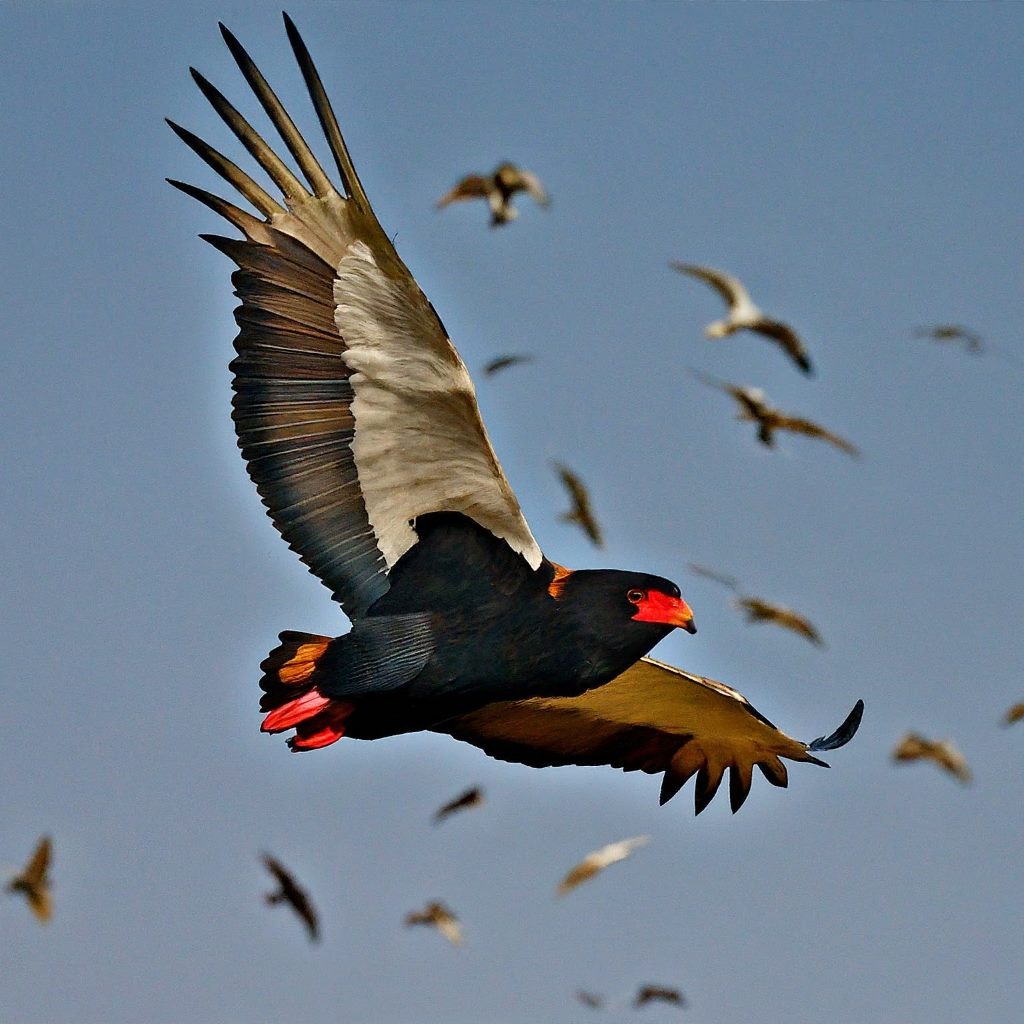
Bateleur
The Bateleur (Terathopius ecaudatus) is a magnificent bird of prey found in sub-Saharan Africa, particularly in savannas, woodlands, and open plains. It belongs to the family Accipitridae and is characterized by its striking black plumage, white underparts, and bright orange face and beak. The Bateleur is a medium-sized eagle with long, broad wings and a short, wedge-shaped tail. Its name, derived from the French word for “acrobat,” reflects its agile flight and aerial maneuvers as it soars over the African landscape in search of prey. Bateleurs are opportunistic hunters and feed on a variety of small mammals, birds, reptiles, and carrion. They are also known for their spectacular courtship displays, which involve aerial acrobatics and vocalizations, making them a captivating sight in the African skies.
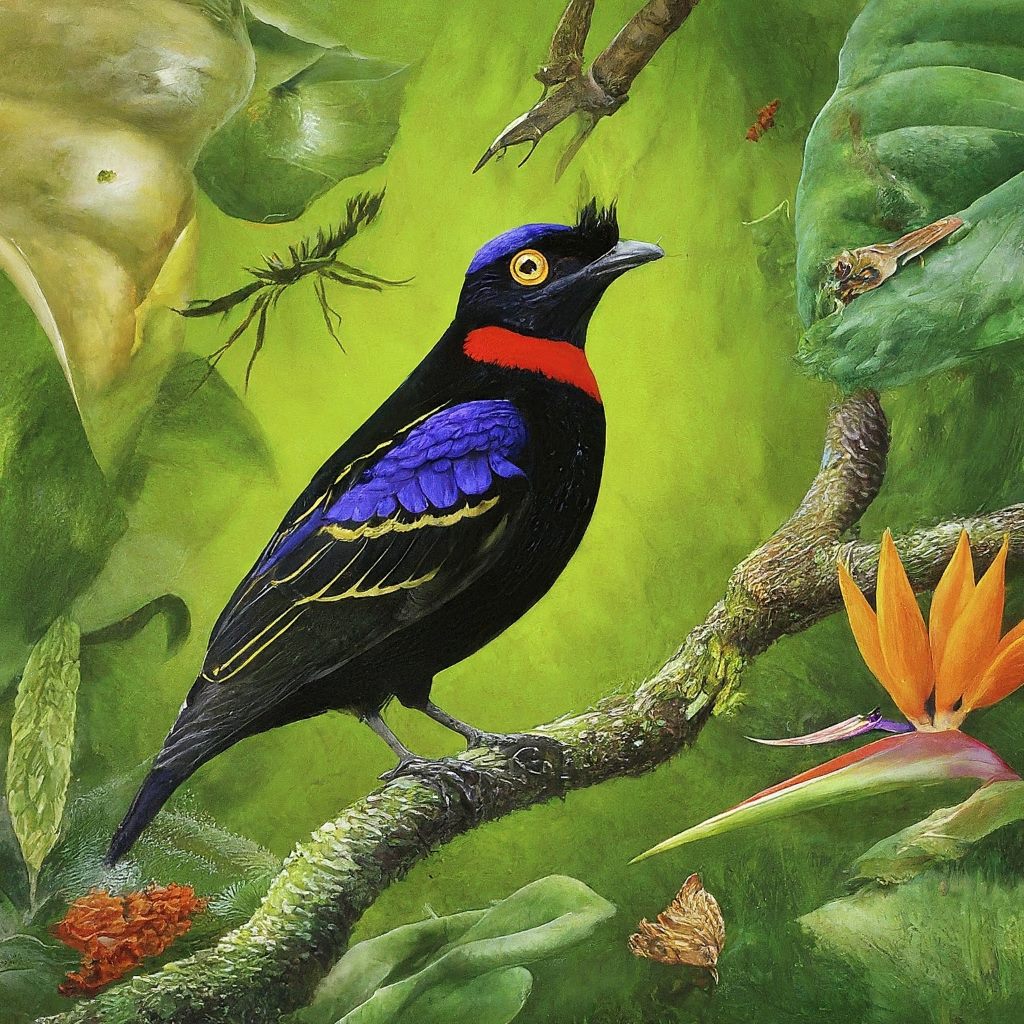
Black And Gold Cotinga
The Black and Gold Cotinga (Tijuca atra) is a stunning passerine bird found in the Atlantic Forest of southeastern Brazil. It belongs to the family Tityridae and is characterized by its glossy black plumage, bright orange-yellow underparts, and contrasting white wing patches. The male Black and Gold Cotinga has a distinctive bright orange beak, while the female has a slightly duller bill. These birds inhabit the dense understory of humid forests, where they feed primarily on fruits, insects, and small invertebrates. They are often observed in mixed-species flocks, foraging together with other canopy-dwelling birds. Despite their striking appearance, Black and Gold Cotingas are relatively elusive and are best observed and appreciated in their natural habitat.
Black Heron
The Black Heron (Egretta ardesiaca) is a distinctive wading bird found in sub-Saharan Africa, particularly in wetlands, marshes, and shallow lakes. It belongs to the family Ardeidae and is characterized by its entirely black plumage, long slender neck, and bright orange bill and legs. The Black Heron has a unique hunting behavior known as “canopy feeding,” where it spreads its wings to create a canopy or umbrella-like structure to shade the water below. This creates a dark environment that attracts fish and other aquatic prey, making it easier for the heron to catch its meals. Black Herons are solitary hunters and are often seen standing motionless in shallow water, waiting patiently for prey to come within striking distance. They are skilled fishermen and have adapted their feeding behavior to maximize their success in capturing aquatic organisms.
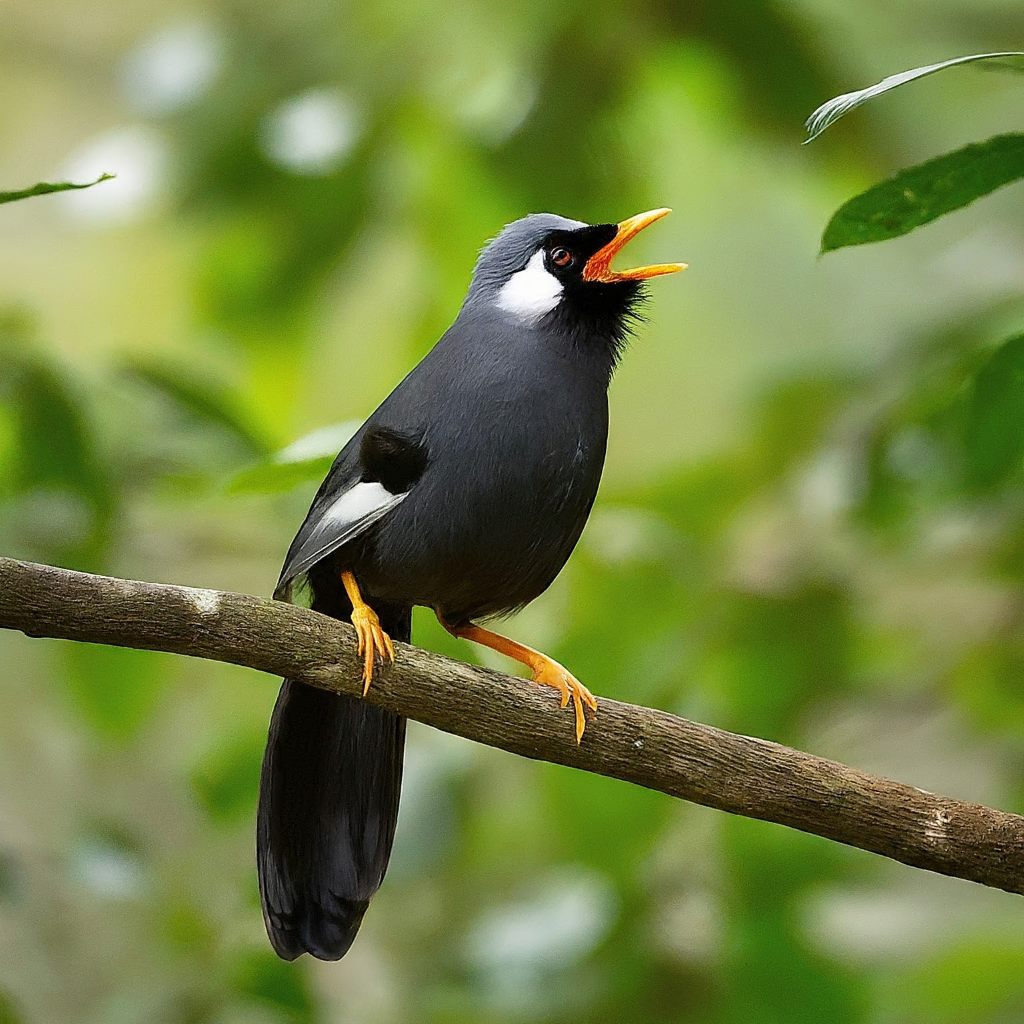
Black Laughing thrush
The Black Laughingthrush (Trochalopteron melanostigma) is a striking songbird found in the eastern Himalayas, particularly in Bhutan, India, and Nepal. It belongs to the family Leiothrichidae and is characterized by its glossy black plumage, bright orange eye-ring, and distinctive white markings on the wings and tail. The Black Laughingthrush is known for its melodious calls and vocalizations, which include loud, raucous laughter-like sounds, giving rise to its name. These birds inhabit dense forests and montane scrub habitats, where they forage for insects, fruits, and seeds. They are often seen in small flocks, hopping and flitting among the branches in search of food. Despite their cryptic coloration, Black Laughingthrushes are prized by birdwatchers for their beautiful plumage and lively behavior.
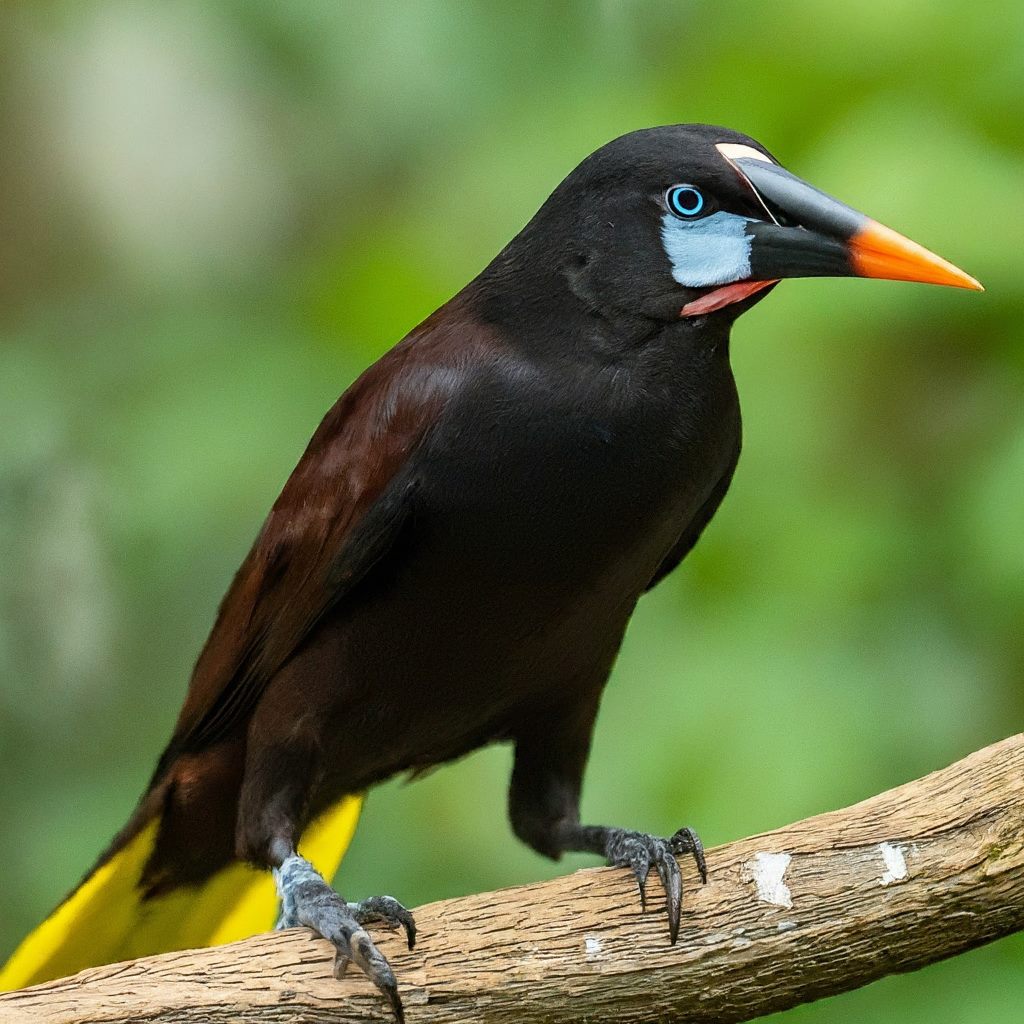
Black Oropendola
The Black Oropendola (Psarocolius guatimozinus) is a large passerine bird found in Central and South America, particularly in the tropical forests of Costa Rica, Panama, and Colombia. It belongs to the family Icteridae and is characterized by its glossy black plumage, bright orange bill, and distinctive hanging nest colonies. The Black Oropendola is known for its intricate woven nests, which are suspended from the branches of tall trees and can contain dozens of individual chambers. These birds are highly social and form large colonies during the breeding season, with multiple males competing for the attention of females through elaborate displays and vocalizations. Black Oropendolas feed primarily on fruits, berries, and insects found in the forest canopy, using their strong bills to crack open tough seeds and husks.
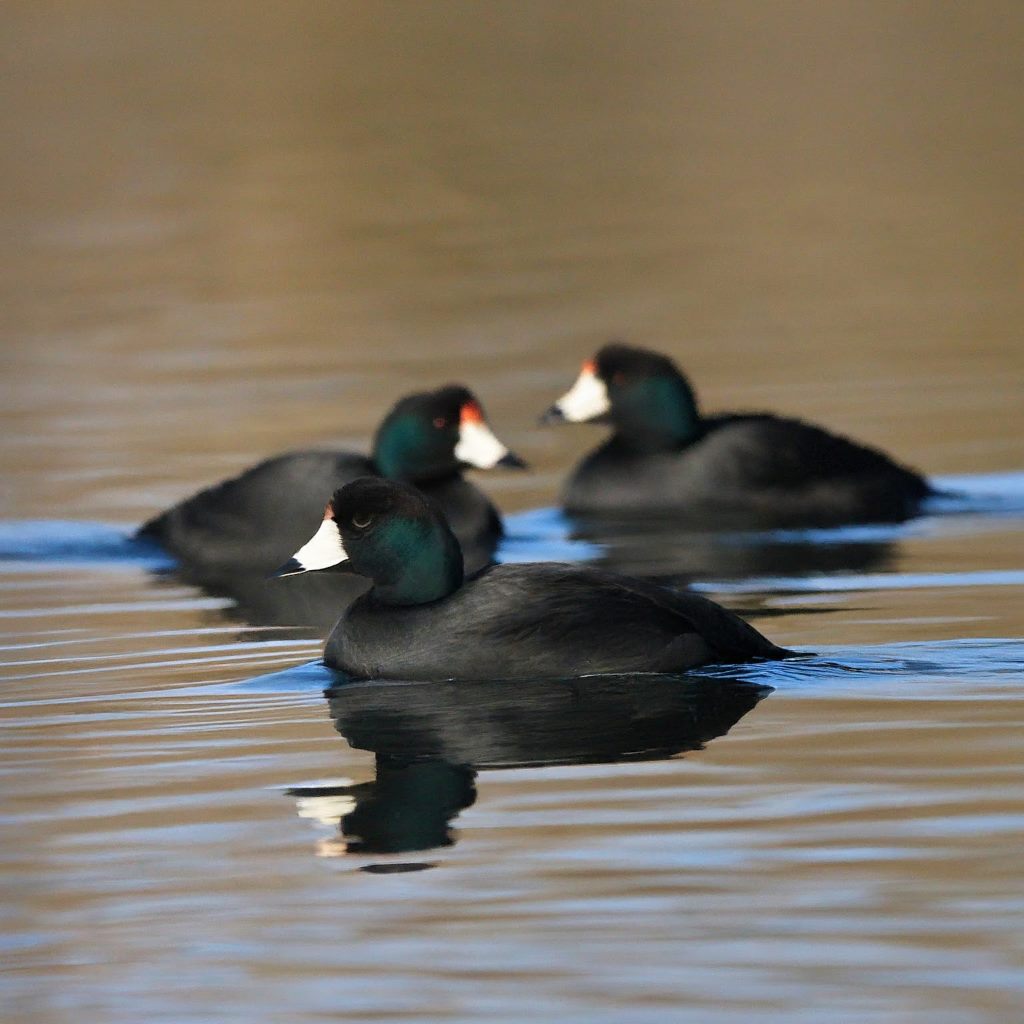
Black Scoter
The Black Scoter (Melanitta americana) is a sea duck found in North America, particularly in the coastal waters of the Arctic and subarctic regions. It belongs to the family Anatidae and is characterized by its entirely black plumage, bright orange bill with a distinctive yellow knob at the base, and contrasting yellow eyes. The male Black Scoter has a slightly larger knob on its bill compared to the female. These ducks are strong swimmers and divers, feeding primarily on mollusks, crustaceans, and aquatic invertebrates found in shallow coastal waters. During the breeding season, Black Scoters migrate to northern tundra habitats, where they nest in open grassy areas near freshwater lakes and ponds. They are highly migratory birds, traveling long distances between their breeding and wintering grounds along coastal migration routes.

Black Skimmer
The Black Skimmer (Rynchops niger) is a unique seabird found along the coasts of North and South America, from the eastern United States to Argentina. It belongs to the family Rynchopidae and is characterized by its striking black and white plumage, long slender wings, and distinctive orange bill with a lower mandible longer than the upper mandible. The Black Skimmer has a specialized feeding technique where it flies low over the water’s surface with its lower mandible submerged, skimming the water for small fish and aquatic invertebrates. Its serrated bill allows it to catch prey with precision as it glides effortlessly over rivers, estuaries, and coastal lagoons. Black Skimmers are social birds and often form large colonies during the breeding season, nesting on sandy beaches and gravel bars along shorelines. They are known for their loud, barking calls and striking aerial displays, making them a captivating sight along coastal habitats.
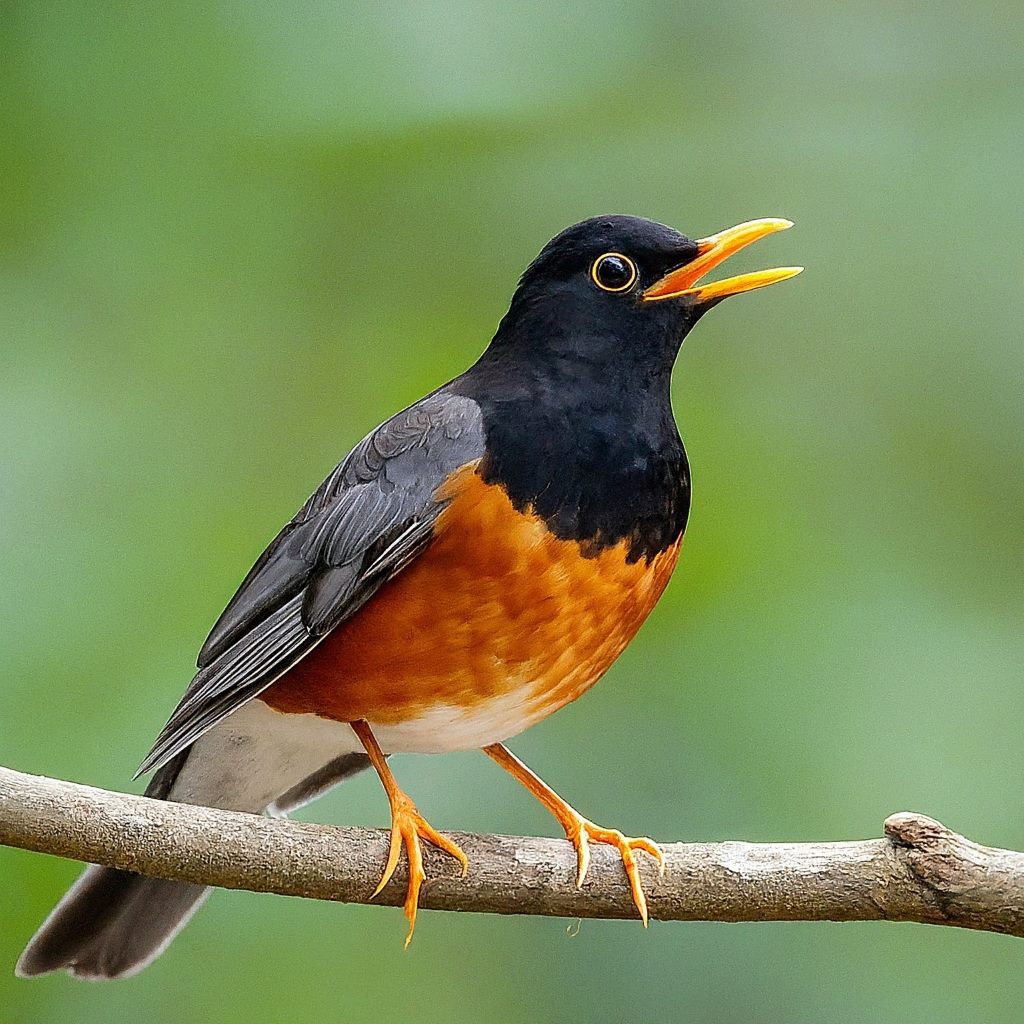
Black breasted Thrush
The Black-breasted Thrush (Turdus dissimilis) is a striking songbird found in the forests and woodlands of Asia, particularly in China, India, and Southeast Asia. It belongs to the family Turdidae and is characterized by its glossy black plumage, bright orange bill, and distinctive white markings on the wings and belly. The male Black-breasted Thrush has a rich black throat and breast, contrasting with its white belly and undertail coverts. These birds inhabit dense undergrowth and forest edges, where they forage for insects, earthworms, and berries. They are often seen hopping and flitting among the branches, using their sharp bill to probe into leaf litter and crevices in search of food. Black-breasted Thrushes are known for their melodious songs and are valued for their role in forest ecosystems as seed dispersers and insect controllers.
Black headed Nightingale Thrush
The Black-headed Nightingale Thrush (Catharus mexicanus) is a beautiful songbird found in the forests and montane habitats of Central and South America, from Mexico to Bolivia. It belongs to the family Turdidae and is characterized by its glossy black plumage, bright orange bill, and distinctive white markings on the wings and belly. The male Black-headed Nightingale Thrush has a striking black head and throat, contrasting with its white belly and undertail coverts. These birds inhabit dense undergrowth and forest edges, where they forage for insects, earthworms, and berries. They are known for their melodious songs, which echo through the forest understory during the breeding season. Black-headed Nightingale Thrushes are secretive and elusive birds, often heard but rarely seen, adding to their allure and mystique in their natural habitat.
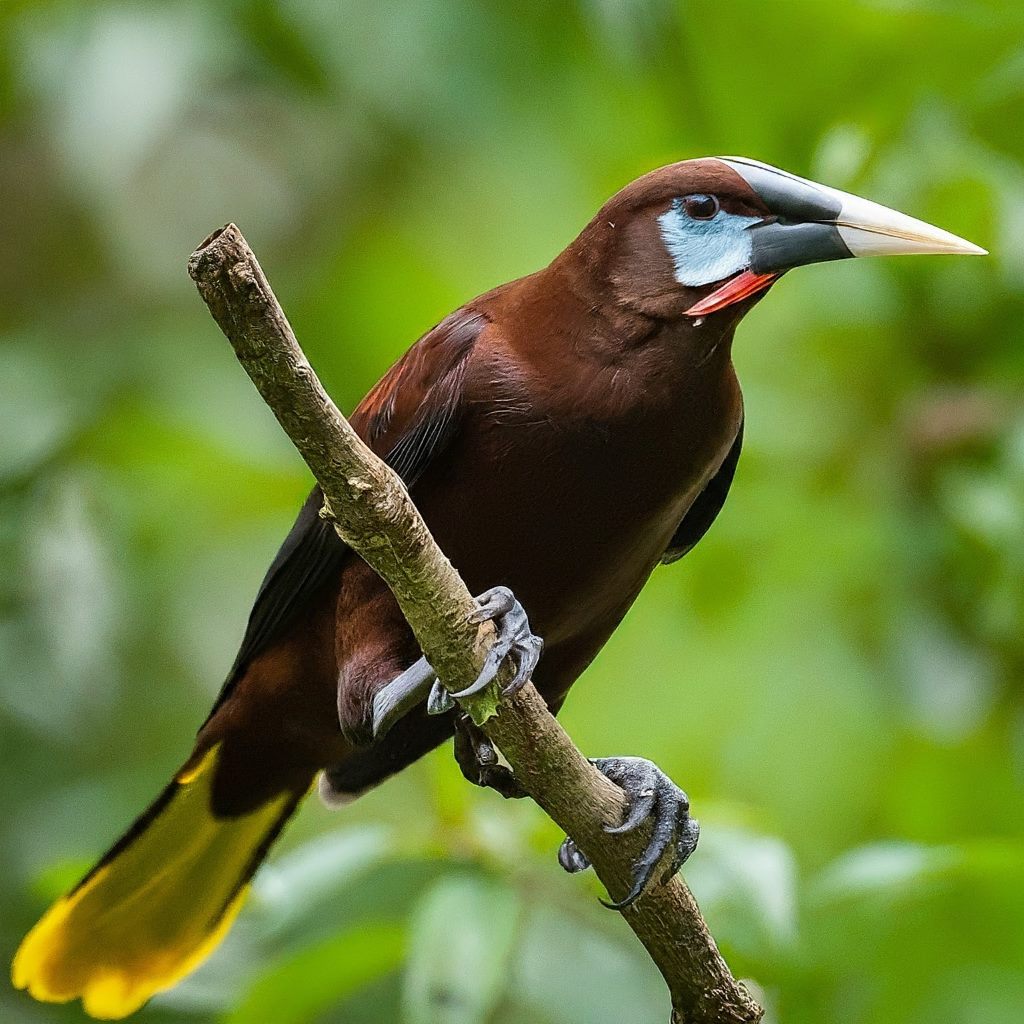
Chestnut headed Oropendola
The Chestnut-headed Oropendola (Psarocolius wagleri) is a striking bird found in Central and South America, particularly in the tropical forests of Colombia, Ecuador, and Peru. It belongs to the family Icteridae and is characterized by its glossy black plumage, bright orange bill, and distinctive hanging nest colonies. The Chestnut-headed Oropendola is named for its chestnut-colored head and throat, which contrast with its black body and wings. These birds are highly social and form large colonies during the breeding season, with multiple males competing for the attention of females through elaborate displays and vocalizations. Chestnut-headed Oropendolas feed primarily on fruits, berries, and insects found in the forest canopy, using their strong bills to crack open tough seeds and husks. They are important seed dispersers and play a vital role in maintaining the health of tropical forest ecosystems.
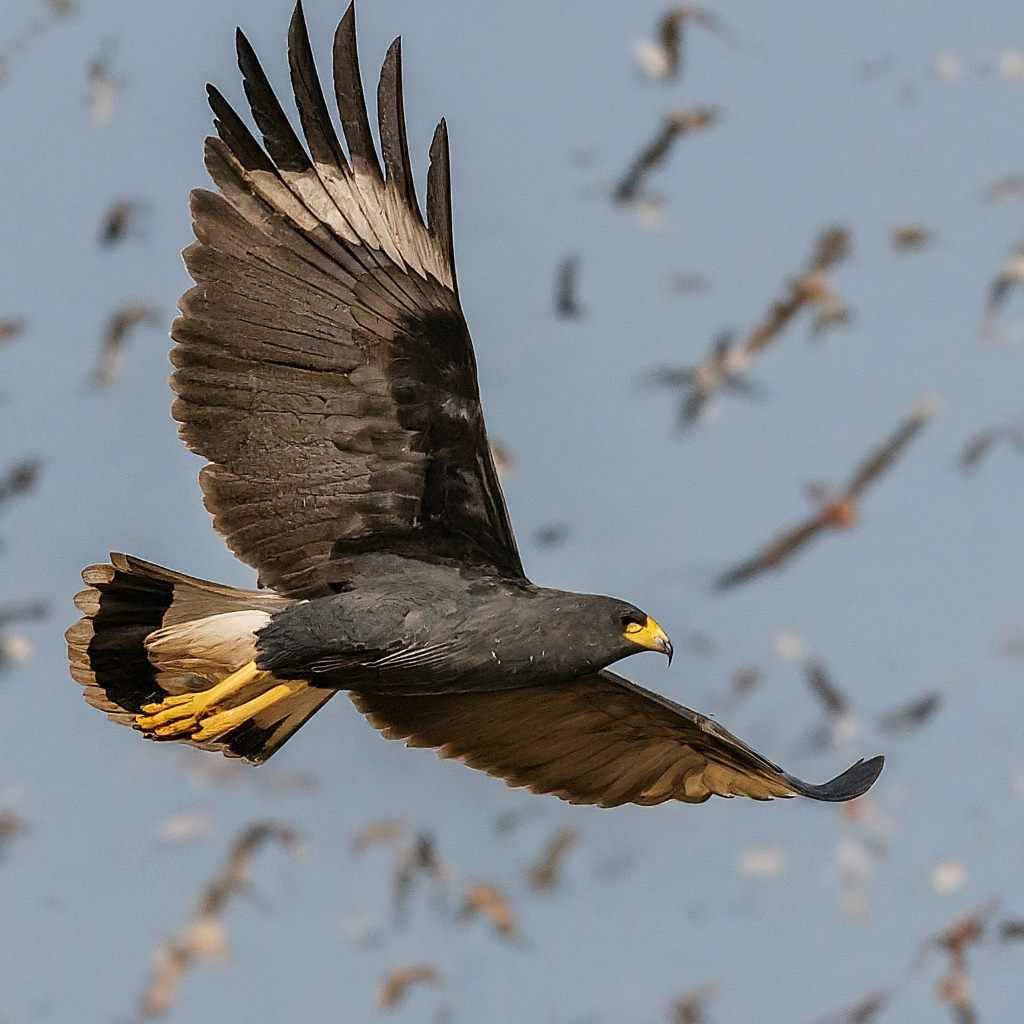
Common Black Hawk
The Common Black Hawk (Buteogallus anthracinus) is a large bird of prey found in Central and South America, particularly in the lowland forests and mangrove swamps of Mexico, Central America, and northern South America. It belongs to the family Accipitridae and is characterized by its glossy black plumage, bright orange legs, and distinctive orange-yellow cere (fleshy area at the base of the bill). The Common Black Hawk has broad wings and a short, rounded tail, ideal for maneuvering through dense vegetation in search of prey. These hawks are opportunistic hunters and feed on a variety of small mammals, birds, reptiles, and amphibians. They are often seen perched on branches overlooking rivers and streams, waiting patiently for prey to come within striking distance. Common Black Hawks are monogamous birds and form long-term pair bonds, often returning to the same nesting sites year after year to raise their chicks.
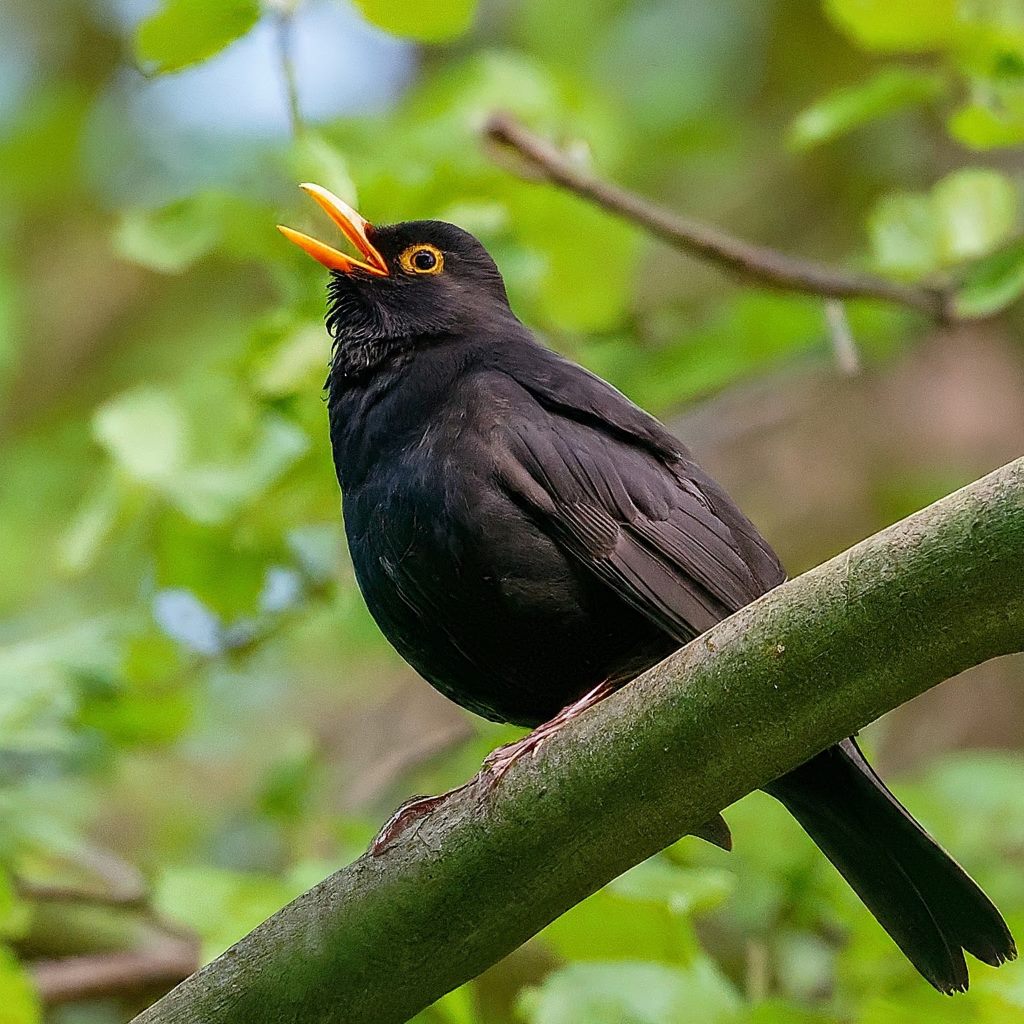
Common Blackbird
The Common Blackbird (Turdus merula) is a widespread songbird found throughout Europe, Asia, and North Africa. It belongs to the family Turdidae and is characterized by its glossy black plumage, bright orange-yellow bill, and distinctive orange eye-ring. The male Common Blackbird has a striking black body with a bright yellow bill, while the female has a duller brown plumage with a darker bill. These birds inhabit a variety of habitats, including woodlands, parks, gardens, and urban areas, where they forage for insects, earthworms, berries, and fruits. They are known for their melodious songs, which echo through the countryside during the breeding season. Common Blackbirds are adaptable birds and are often seen hopping and foraging on the ground, using their sharp bill to probe into leaf litter and soil in search of food.
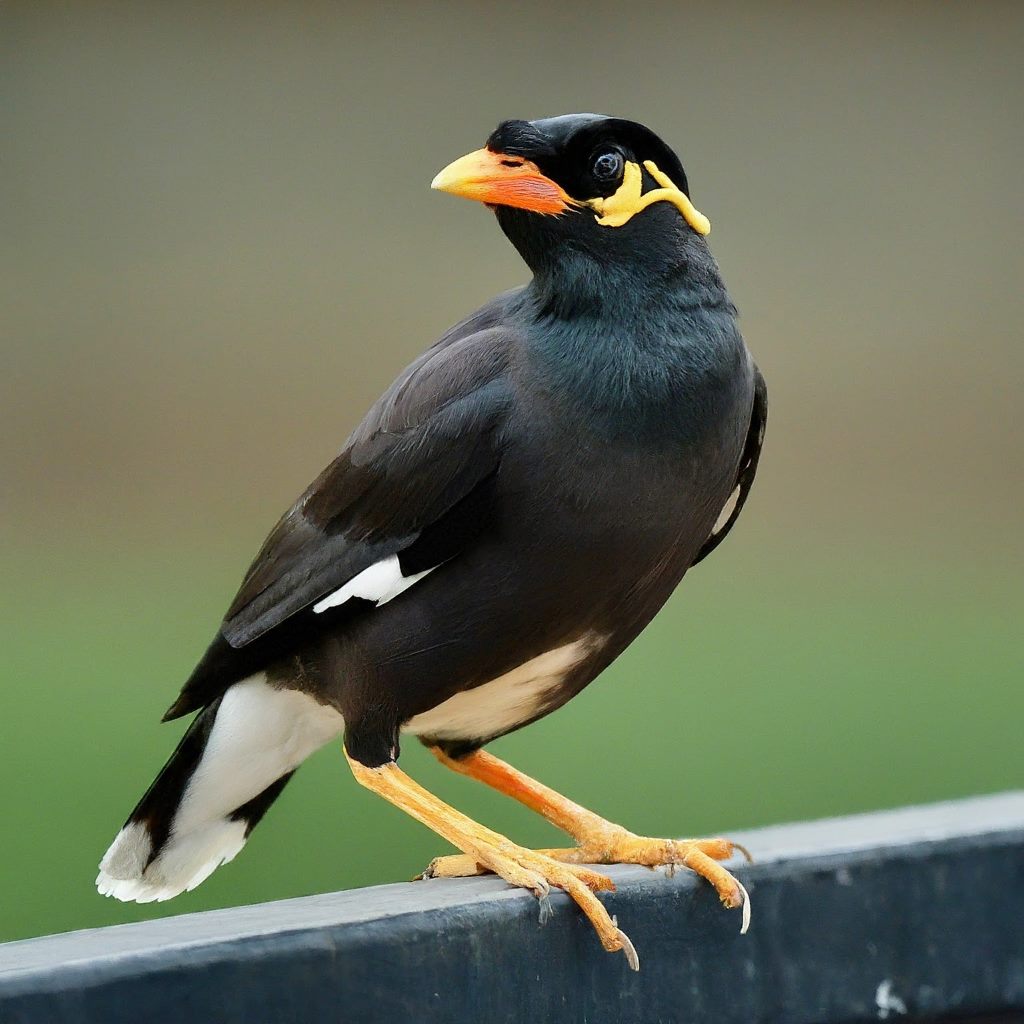
Common Hill Myna
The Common Hill Myna (Gracula religiosa) is a striking songbird found in the forests and woodlands of South and Southeast Asia, from India to Indonesia. It belongs to the family Sturnidae and is characterized by its glossy black plumage, bright orange bill, and distinctive yellow eye-patch. The Common Hill Myna has a loud, raucous call and is known for its ability to mimic human speech and other sounds. These birds are highly social and often form large flocks, roosting together in the canopy of tall trees. Common Hill Mynas are omnivorous and feed on a variety of fruits, insects, and small vertebrates found in their habitat. They are also popular as pets and are often kept in captivity for their talking ability and entertaining behavior.
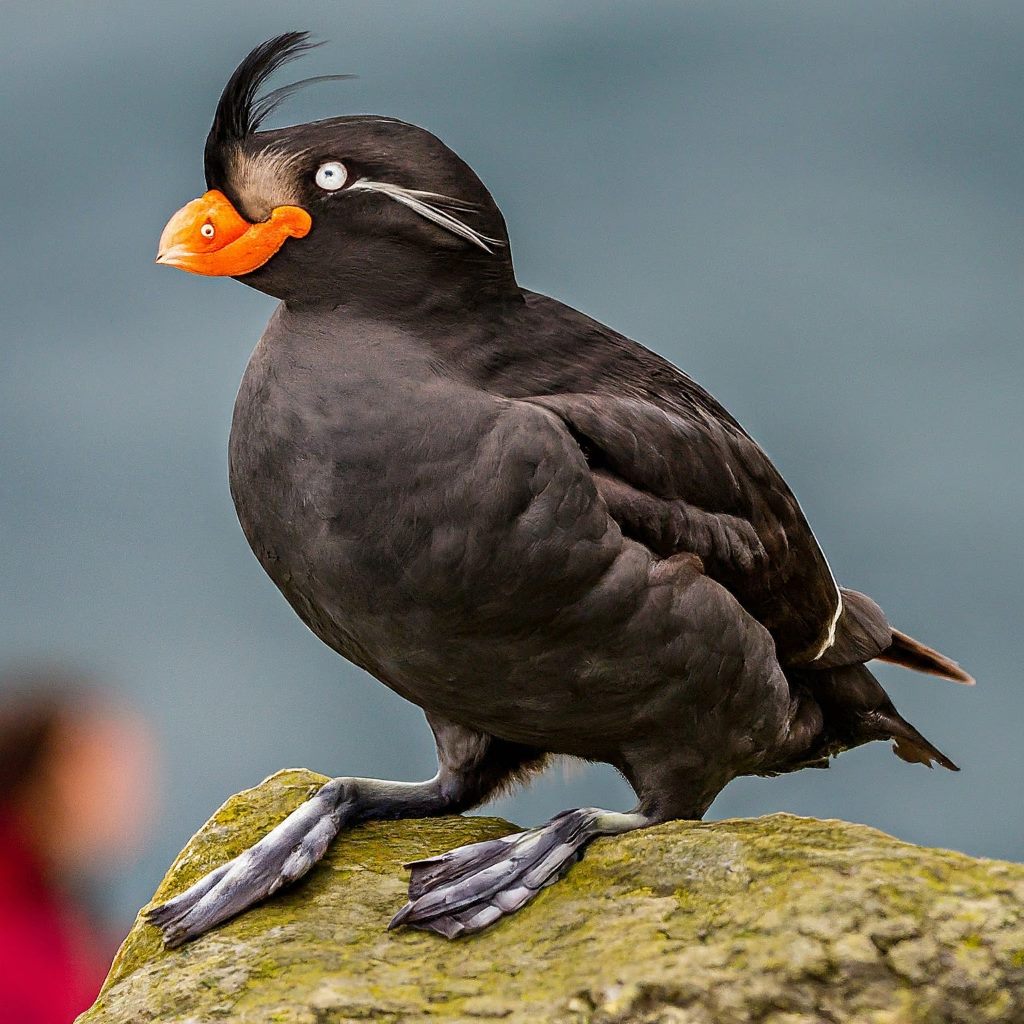
Crested Auklet
The Crested Auklet (Aethia cristatella) is a seabird found in the North Pacific Ocean, particularly in the coastal waters of Alaska, Russia, and Japan. It belongs to the family Alcidae and is characterized by its distinctive black and white plumage, bright orange bill, and striking crest of yellow plumes on its forehead. The Crested Auklet has a compact body with short wings and a stubby tail, ideal for diving and swimming underwater in search of prey. These birds feed primarily on small fish, crustaceans, and planktonic organisms, which they catch by plunge-diving from the air or diving beneath the surface of the water. Crested Auklets are highly gregarious and often form large colonies during the breeding season, nesting on rocky cliffs and offshore islands. They are known for their raucous calls and social behaviors, including elaborate courtship displays and synchronized swimming.
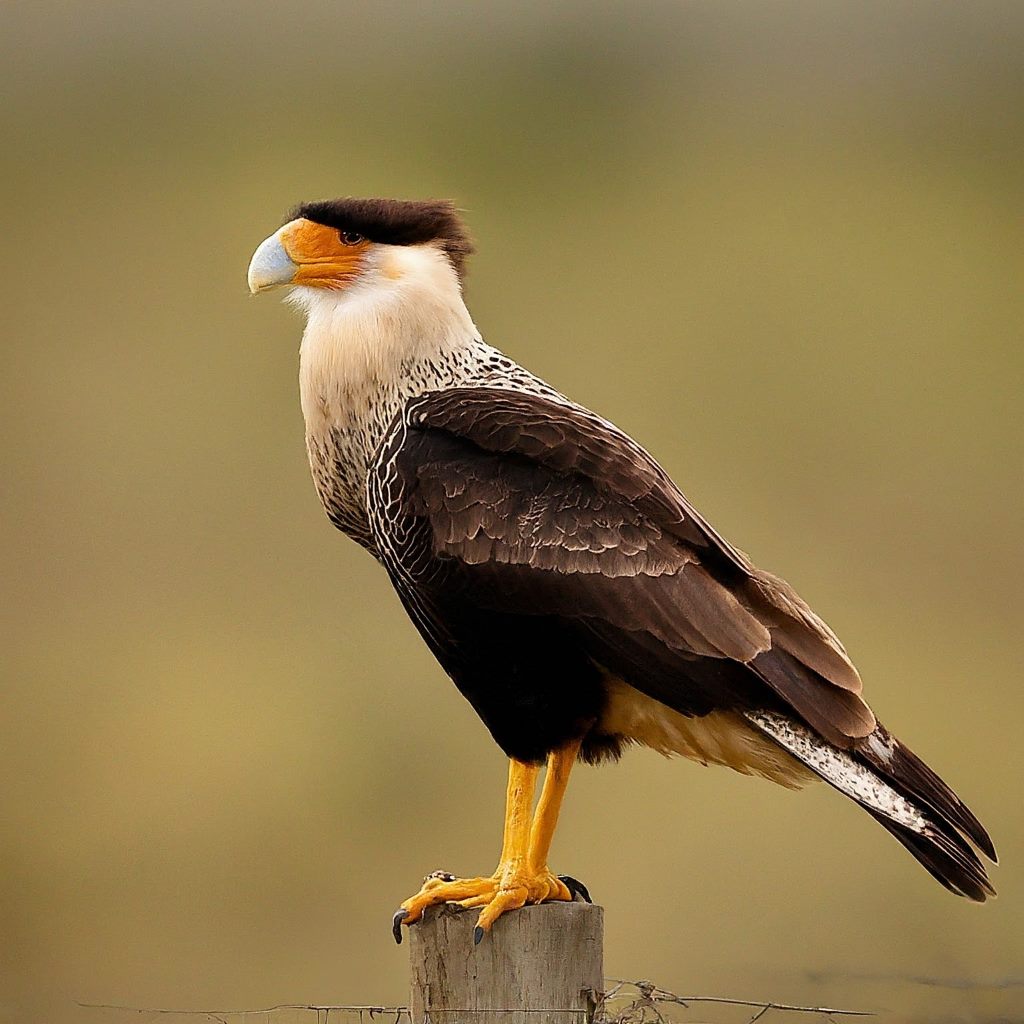
Crested Caracara
The Crested Caracara (Caracara plancus) is a striking bird of prey found in the Americas, particularly in the southern United States, Central America, and South America. It belongs to the family Falconidae and is characterized by its distinctive black and white plumage, bright orange facial skin, and prominent crest of feathers on its head. The Crested Caracara has a powerful bill and sharp talons, which it uses to catch a variety of prey, including small mammals, birds, reptiles, and carrion. These birds are often seen foraging on the ground, scavenging for food in open grasslands, agricultural fields, and marshy areas. They are also known for their opportunistic feeding behavior, often following large mammals or birds of prey to steal food or scavenge from their kills. Crested Caracaras are highly adaptable birds and are often found in urban and suburban areas, where they are known for their bold and fearless behavior.
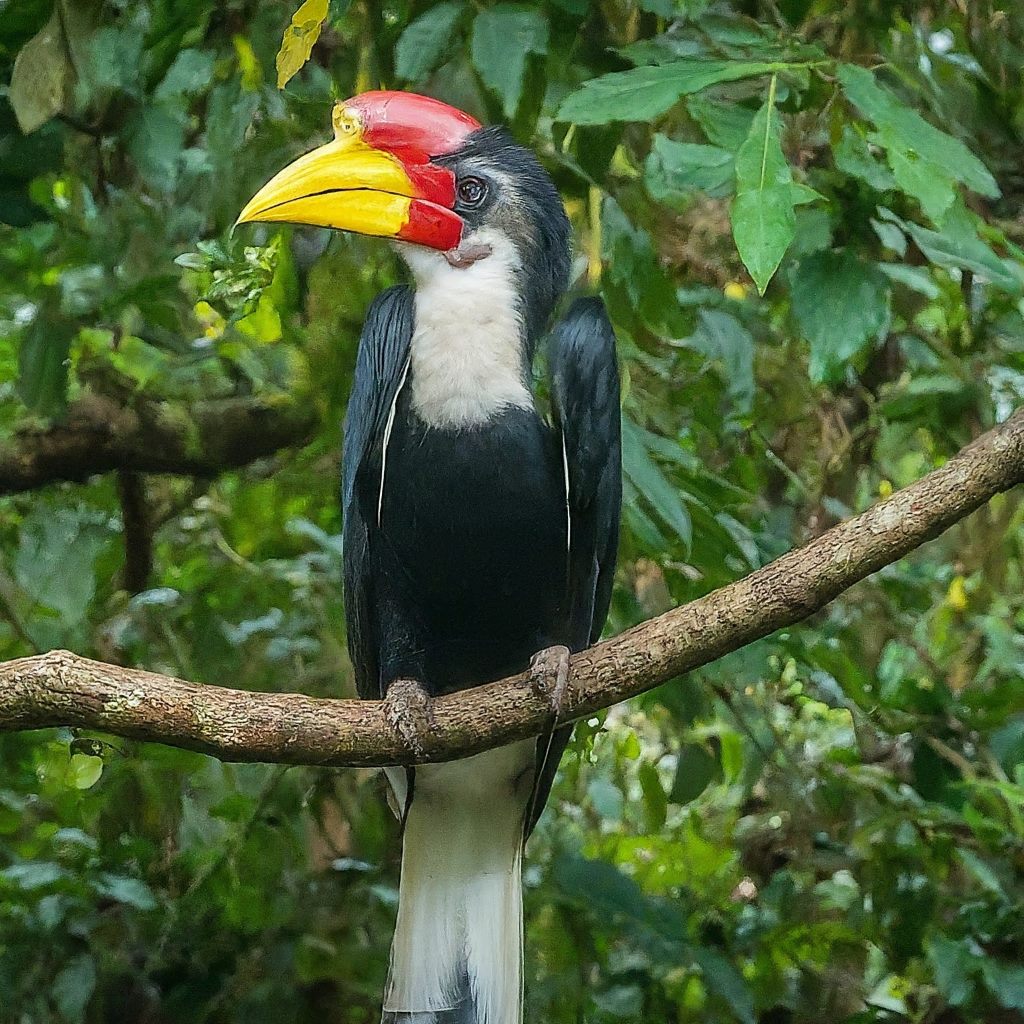
Crowned Hornbill
The Crowned Hornbill (Lophoceros alboterminatus) is a striking bird found in sub-Saharan Africa, particularly in the woodlands and savannas of East Africa. It belongs to the family Bucerotidae and is characterized by its glossy black plumage, bright orange bill with a distinctive casque (horn-like structure) on top, and white belly and tail feathers. The Crowned Hornbill has a large and powerful bill, which it uses to catch a variety of prey, including insects, small mammals, birds, and reptiles. These birds are often seen foraging in the canopy of tall trees, using their sharp bill to probe into crevices and extract prey. They are also known for their loud, raucous calls and vocalizations, which echo through the forest during the breeding season. Crowned Hornbills are monogamous birds and form long-term pair bonds, often returning to the same nesting sites year after year to raise their chicks.
Rhinoceros Hornbill
The Rhinoceros Hornbill (Buceros rhinoceros) is a stunning bird found in the forests and woodlands of Southeast Asia, particularly in Malaysia, Indonesia, and Thailand. It belongs to the family Bucerotidae and is characterized by its large size, glossy black plumage, bright orange bill with a distinctive casque (horn-like structure) on top, and white belly and tail feathers. The Rhinoceros Hornbill has a loud, raucous call and is often heard before it is seen, announcing its presence in the forest canopy. These birds feed primarily on fruits, insects, small mammals, and birds, which they catch by swooping down from the treetops with their powerful bill. Rhinoceros Hornbills are also important seed dispersers and play a vital role in maintaining the health of tropical forest ecosystems.
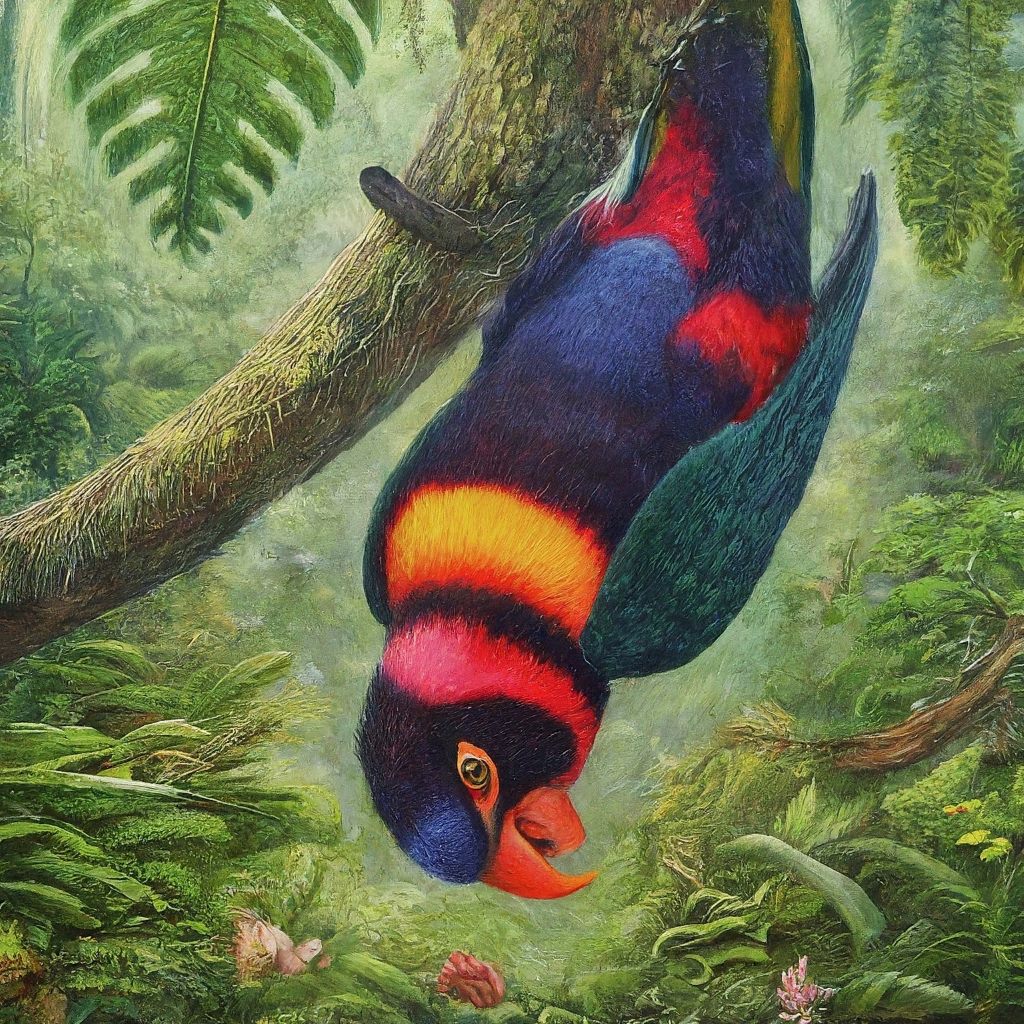
Dusky Lory
The Dusky Lory (Pseudeos fuscata) is a beautiful parrot species found in New Guinea and nearby islands in the southwestern Pacific Ocean. It belongs to the family Psittaculidae and is characterized by its dusky black plumage, bright orange beak, and striking orange-red markings on its face, wings, and tail. The Dusky Lory is often found in dense rainforests and lowland habitats, where it feeds on nectar, pollen, fruits, and seeds. These birds are highly social and often form large flocks, roosting together in the canopy of tall trees. Dusky Lorikeets are known for their vocalizations, including loud screeches, whistles, and chattering calls, which they use to communicate with each other and defend their territories. They are also popular as pets and are prized for their beautiful plumage and playful behavior.
Eurasian Blackbird
The Eurasian Blackbird (Turdus merula) is a widespread songbird found throughout Europe, Asia, and North Africa. It belongs to the family Turdidae and is characterized by its glossy black plumage, bright orange-yellow bill, and distinctive orange eye-ring. The male Eurasian Blackbird has a striking black body with a bright yellow bill, while the female has a duller brown plumage with a darker bill. These birds inhabit a variety of habitats, including woodlands, parks, gardens, and urban areas, where they forage for insects, earthworms, berries, and fruits. They are known for their melodious songs, which echo through the countryside during the breeding season. Eurasian Blackbirds are adaptable birds and are often seen hopping and foraging on the ground, using their sharp bill to probe into leaf litter and soil in search of food.
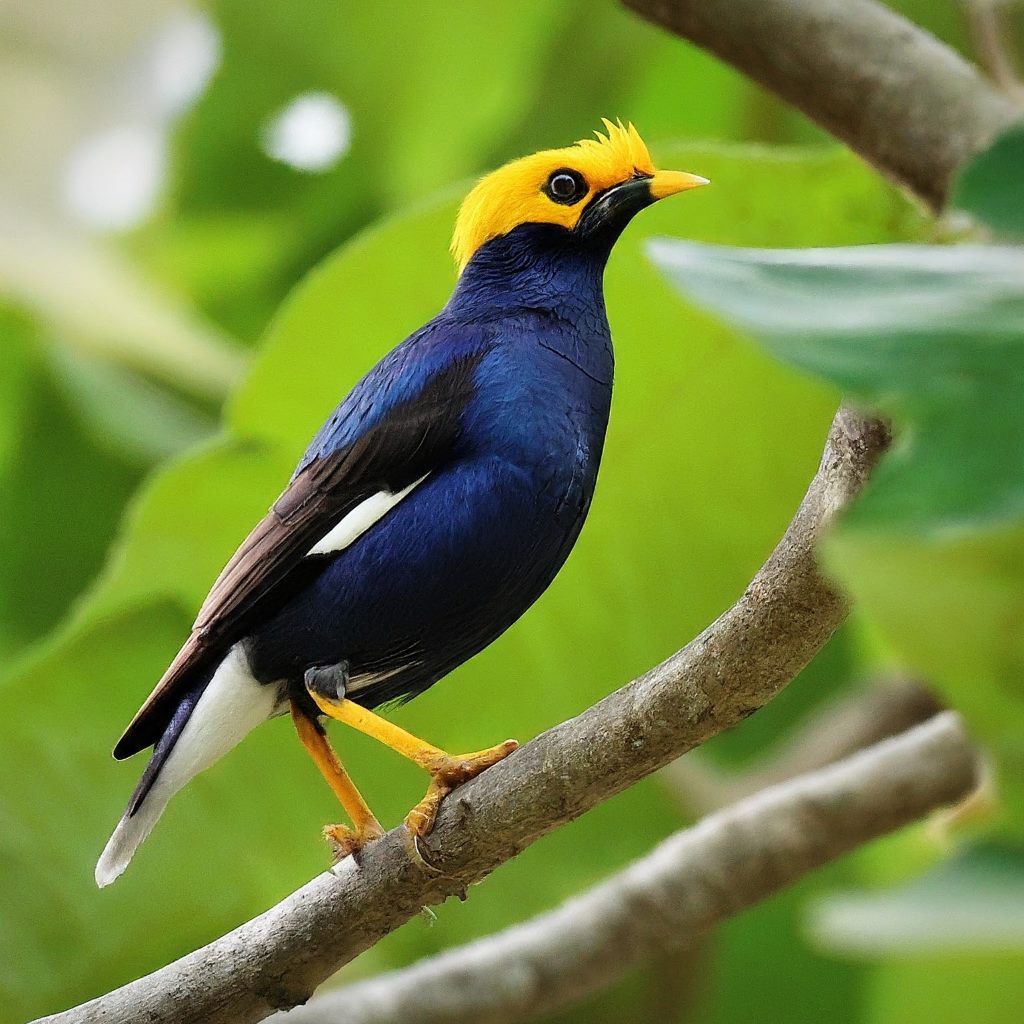
Golden Crested Myna
The Golden Crested Myna (Ampeliceps coronatus) is a striking songbird found in the forests and woodlands of Southeast Asia, particularly in Myanmar, Thailand, and Malaysia. It belongs to the family Sturnidae and is characterized by its glossy black plumage, bright orange bill, and distinctive golden-yellow crest on its head. The Golden Crested Myna has a loud, melodious call and is known for its ability to mimic human speech and other sounds. These birds are highly social and often form large flocks, roosting together in the canopy of tall trees. Golden Crested Mynas are omnivorous and feed on a variety of fruits, insects, and small vertebrates found in their habitat. They are also popular as pets and are often kept in captivity for their talking ability and entertaining behavior.
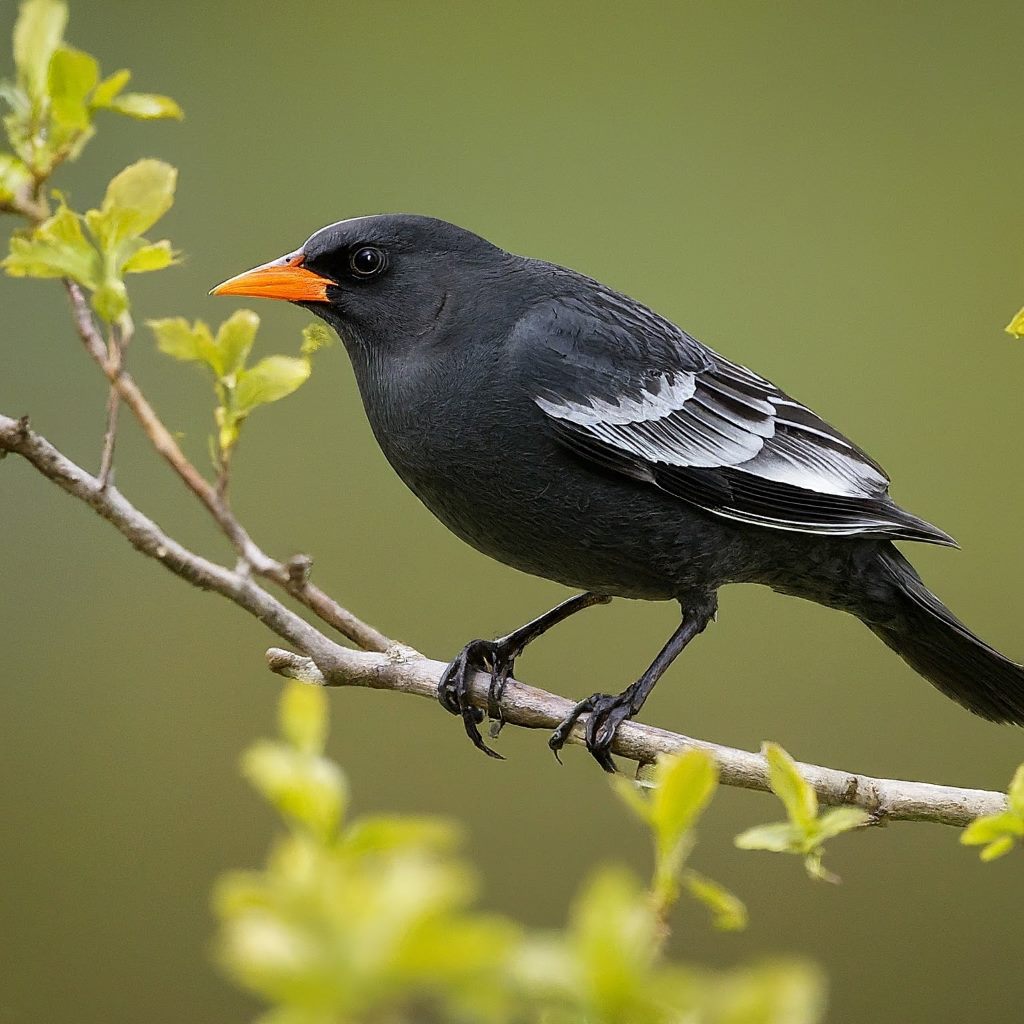
Gray winged Blackbird
The Gray-winged Blackbird (Agelaius phoeniceus) is a striking songbird found in North and South America, particularly in wetlands, marshes, and grasslands. It belongs to the family Icteridae and is characterized by its glossy black plumage, bright orange bill, and distinctive gray wings and back. The Gray-winged Blackbird is often found in large flocks, foraging together in open fields and wetland habitats. These birds are omnivorous and feed on a variety of foods, including seeds, grains, insects, and small invertebrates. They are known for their loud, melodious songs and vocalizations, which echo through the countryside during the breeding season. Gray-winged Blackbirds are also important seed dispersers and play a vital role in maintaining the health of wetland ecosystems.

Great Cormorant
The Great Cormorant (Phalacrocorax carbo) is a large seabird found in coastal regions and inland waterways throughout the world. It belongs to the family Phalacrocoracidae and is characterized by its sleek black plumage, bright orange-yellow bill, and distinctive hooked beak. The Great Cormorant has a long, slender neck and powerful webbed feet, which make it an agile swimmer and diver. These birds feed primarily on fish, crustaceans, and other aquatic prey, which they catch by diving beneath the surface of the water and pursuing their prey underwater. Great Cormorants are often seen perched on rocks, buoys, and tree branches, drying their wings in the sun after a fishing expedition. They are also known for their communal roosting sites, where hundreds or even thousands of birds gather together to rest and preen.
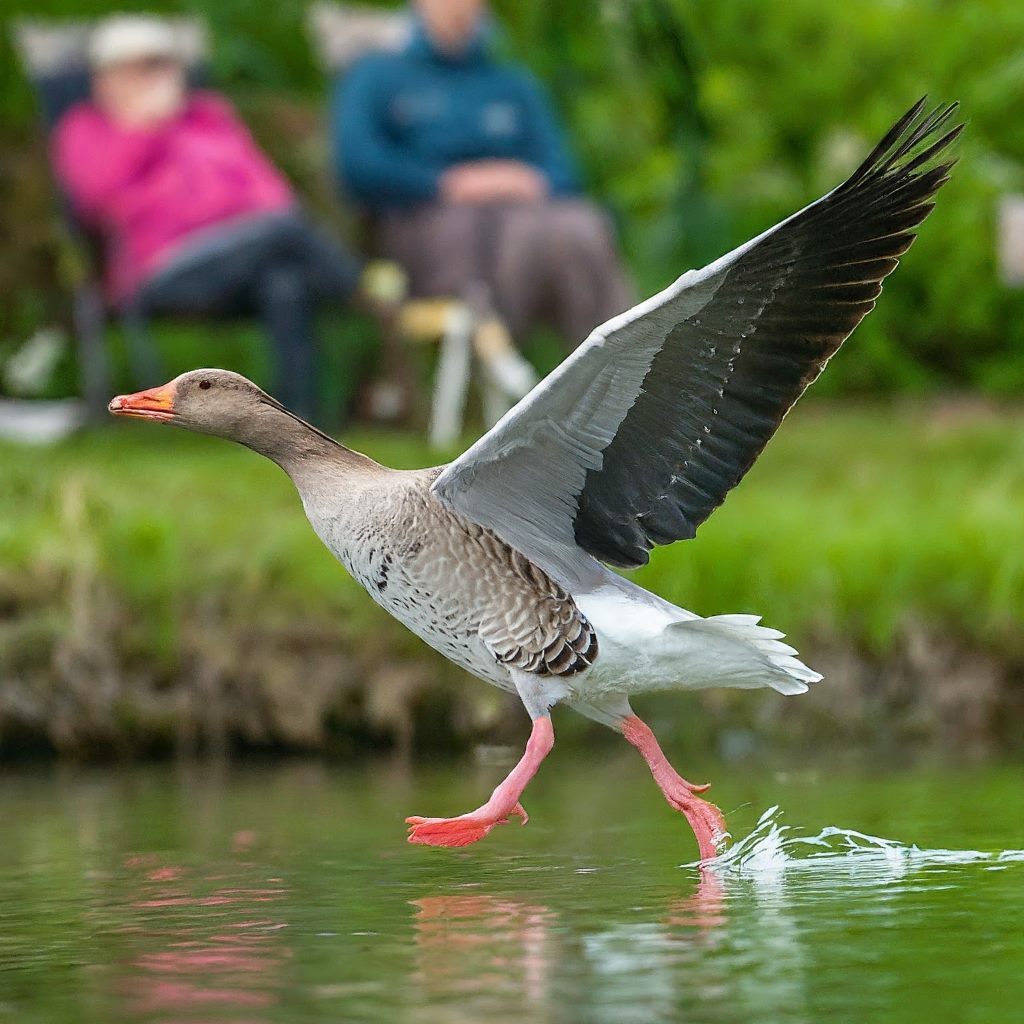
Greylag Goose
The Greylag Goose (Anser anser) is a large waterfowl species found throughout Europe and Asia, as well as parts of North Africa. It belongs to the family Anatidae and is characterized by its gray-brown plumage, bright orange bill, and distinctive pink legs. The Greylag Goose has a long neck and a bulky body, with males typically larger than females. These birds inhabit a variety of wetland habitats, including lakes, rivers, marshes, and coastal estuaries, where they feed on aquatic plants, grasses, and grains. They are often seen grazing on land or swimming in shallow water, using their broad, webbed feet to propel themselves through the water. Greylag Geese are highly social and often form large flocks during the winter months, migrating between their breeding and wintering grounds in search of food and suitable habitat.
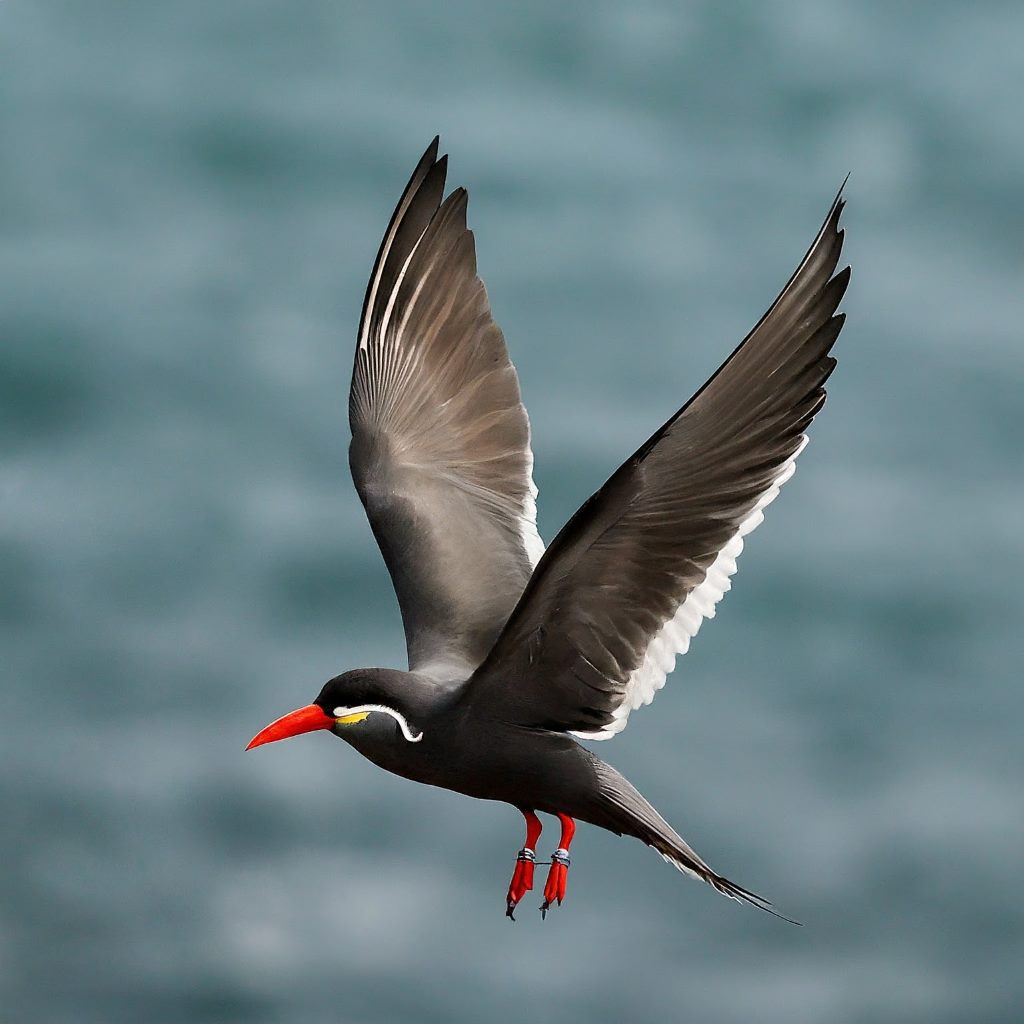
Inca Tern
The Inca Tern (Larosterna inca) is a striking seabird found along the western coast of South America, from Peru to Chile. It belongs to the family Laridae and is characterized by its distinctive black and white plumage, bright orange bill, and striking facial markings, including a white mustache and red-orange bill and feet. The Inca Tern has a long, slender body and pointed wings, which make it an agile flier and adept at catching fish in mid-air. These birds feed primarily on small fish and crustaceans, which they catch by plunge-diving from the air or skimming the surface of the water with their bill. Inca Terns are often seen nesting on rocky cliffs and offshore islands, where they form large colonies during the breeding season. They are known for their raucous calls and vocalizations, which echo through the coastal landscape.
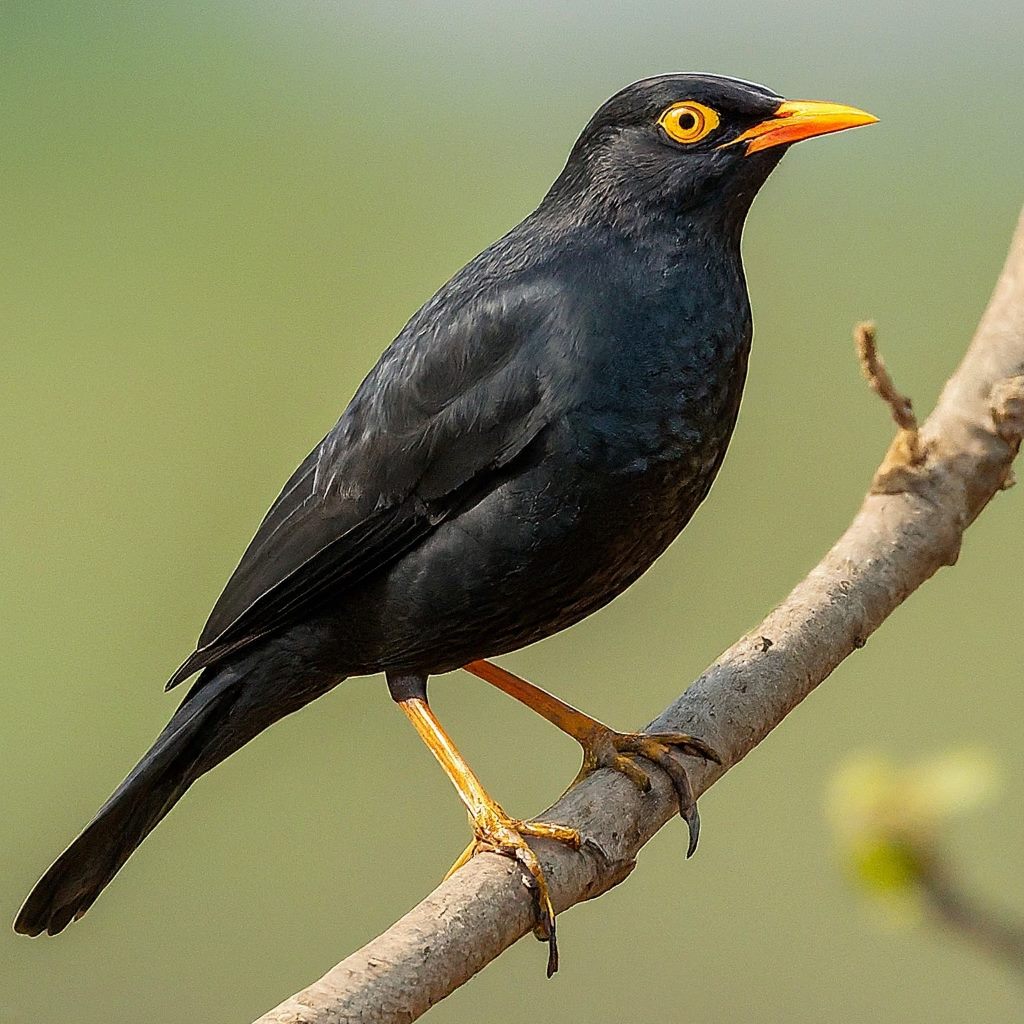
Indian Blackbird
The Indian Blackbird (Turdus simillimus) is a striking songbird found in South Asia, particularly in India, Nepal, and Bangladesh. It belongs to the family Turdidae and is characterized by its glossy black plumage, bright orange bill, and distinctive white markings on the wings and belly. The male Indian Blackbird has a striking black body with a bright yellow bill, while the female has a duller brown plumage with a darker bill. These birds inhabit a variety of habitats, including woodlands, parks, gardens, and urban areas, where they forage for insects, earthworms, berries, and fruits. They are known for their melodious songs, which echo through the countryside during the breeding season. Indian Blackbirds are adaptable birds and are often seen hopping and foraging on the ground, using their sharp bill to probe into leaf litter and soil in search of food.
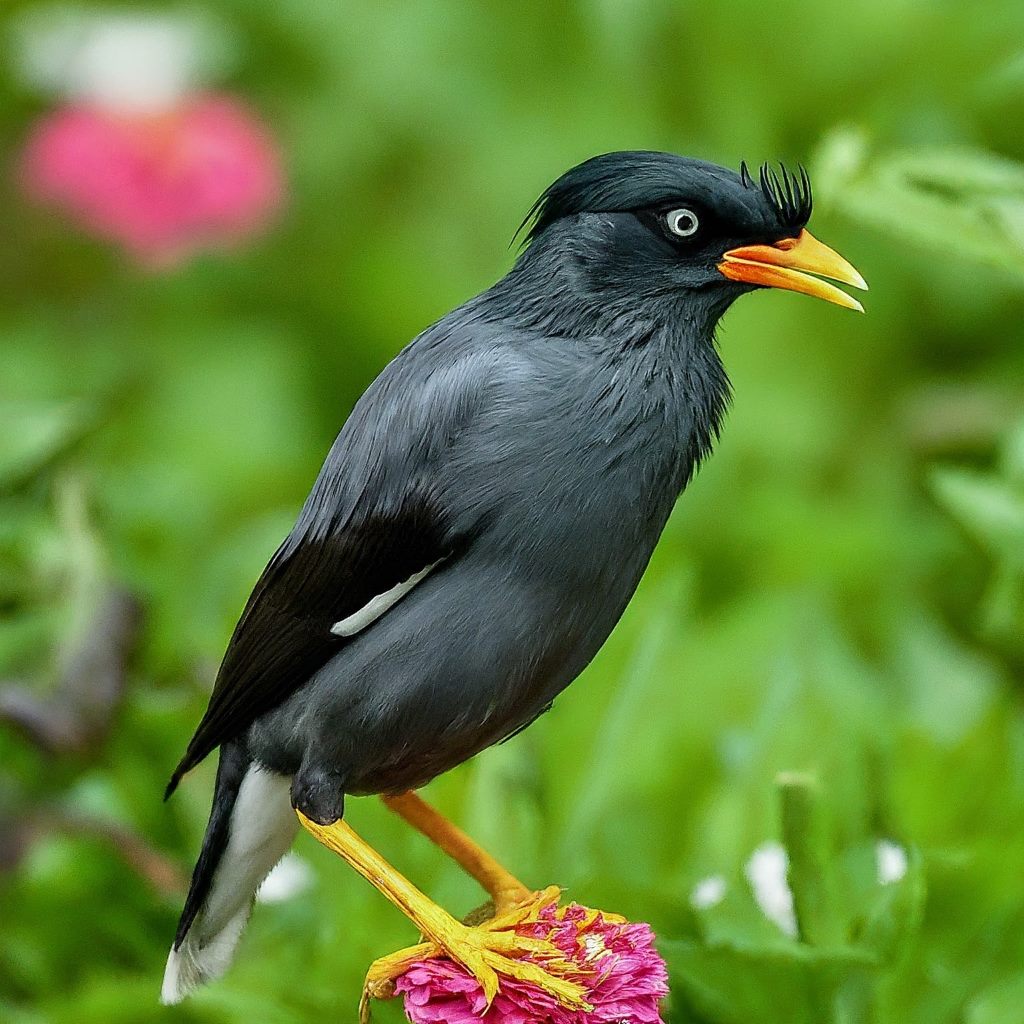
Javan Myna
The Javan Myna (Acridotheres javanicus) is a common bird species found in Southeast Asia, particularly in Indonesia, Malaysia, and Singapore. It belongs to the family Sturnidae and is characterized by its glossy black plumage, bright orange-yellow bill, and distinctive yellow eye-patch. The Javan Myna is often found in urban and suburban areas, where it forages for food in parks, gardens, and city streets. These birds are omnivorous and feed on a variety of foods, including fruits, insects, grains, and human food scraps. They are highly adaptable and opportunistic, often taking advantage of human habitation to find food and nesting sites. Javan Mynas are also known for their vocalizations, including loud squawks, whistles, and mimicry of other bird species.
Keel billed Toucan
The Keel-billed Toucan (Ramphastos sulfuratus) is a stunning bird found in the tropical forests of Central and South America, from southern Mexico to northern Colombia. It belongs to the family Ramphastidae and is characterized by its large, colorful bill, bright orange throat, and striking black plumage with yellow and red markings on its breast and tail. The Keel-billed Toucan has a long, slender bill with a serrated edge, which it uses to reach fruits, insects, and small vertebrates in the canopy of tall trees. These birds are often seen in small flocks, hopping and flitting among the branches in search of food. Keel-billed Toucans are also known for their loud, croaking calls and vocalizations, which echo through the forest canopy during the breeding season. They are important seed dispersers and play a vital role in maintaining the health of tropical forest ecosystems.
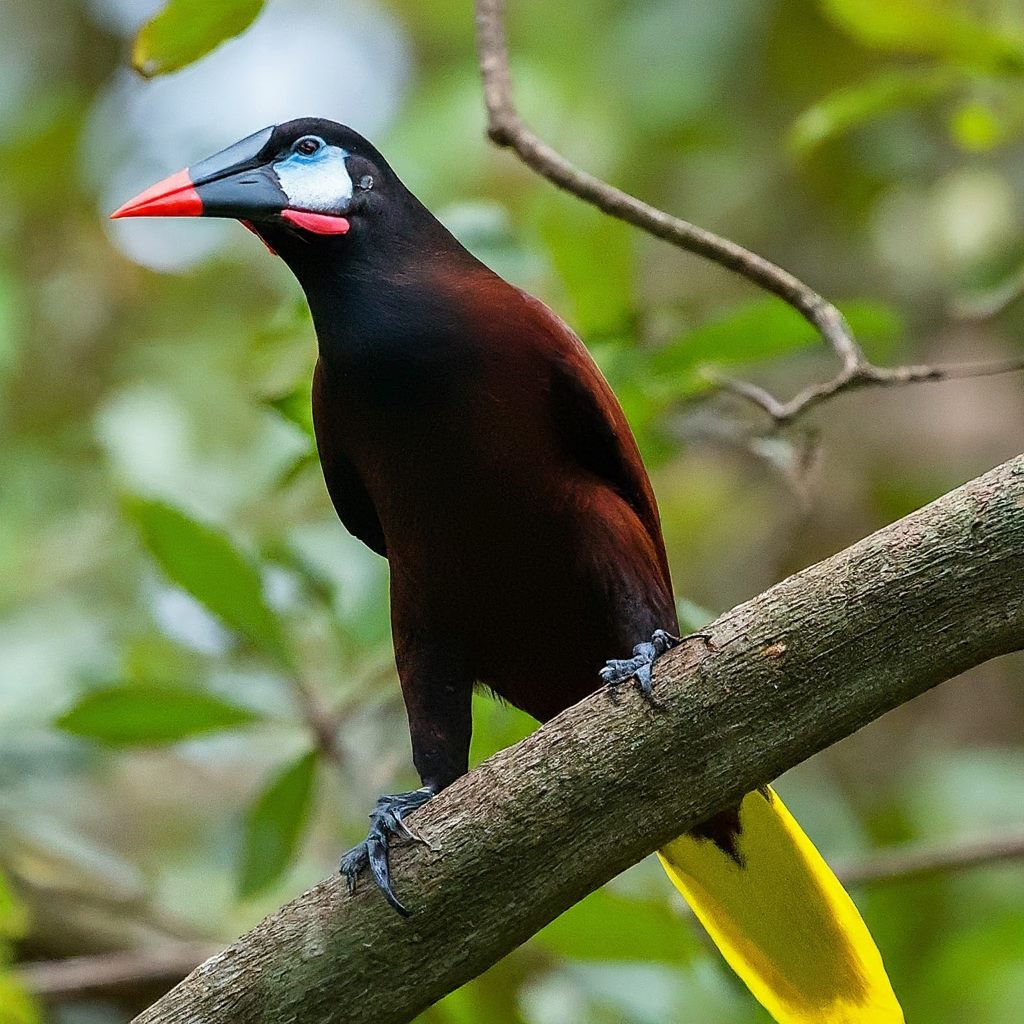
Montezuma Oropendola
The Montezuma Oropendola (Psarocolius montezuma) is a striking bird found in Central and South America, particularly in the tropical forests of Mexico, Guatemala, and Costa Rica. It belongs to the family Icteridae and is characterized by its glossy black plumage, bright orange bill, and distinctive hanging nest colonies. The Montezuma Oropendola is named for the Aztec emperor Montezuma and is revered as a symbol of tropical biodiversity. These birds are highly social and form large colonies during the breeding season, with multiple males competing for the attention of females through elaborate displays and vocalizations. Montezuma Oropendolas feed primarily on fruits, berries, and insects found in the forest canopy, using their strong bills to crack open tough seeds and husks. They are important seed dispersers and play a vital role in maintaining the health of tropical forest ecosystems.
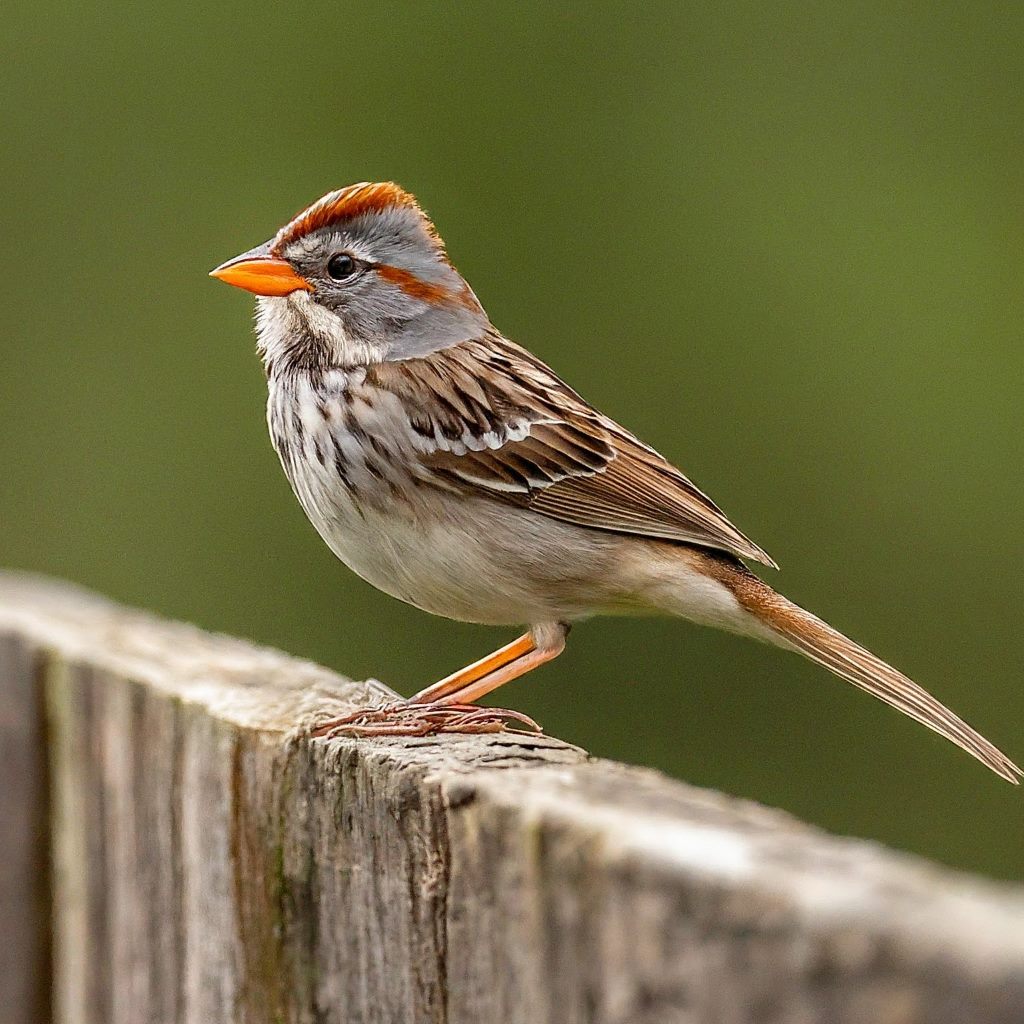
Orange billed Sparrow
The Orange-billed Sparrow (Arremon aurantiirostris) is a small songbird found in Central and South America, particularly in the forests and woodlands of Mexico, Guatemala, and Honduras. It belongs to the family Passerellidae and is characterized by its dusky brown plumage, bright orange bill, and distinctive white throat and breast. The Orange-billed Sparrow is often found in dense undergrowth and forest edges, where it forages for insects, seeds, and berries. These birds are known for their melodious songs, which echo through the forest during the breeding season. Orange-billed Sparrows are also important seed dispersers and play a vital role in maintaining the health of forest ecosystems.
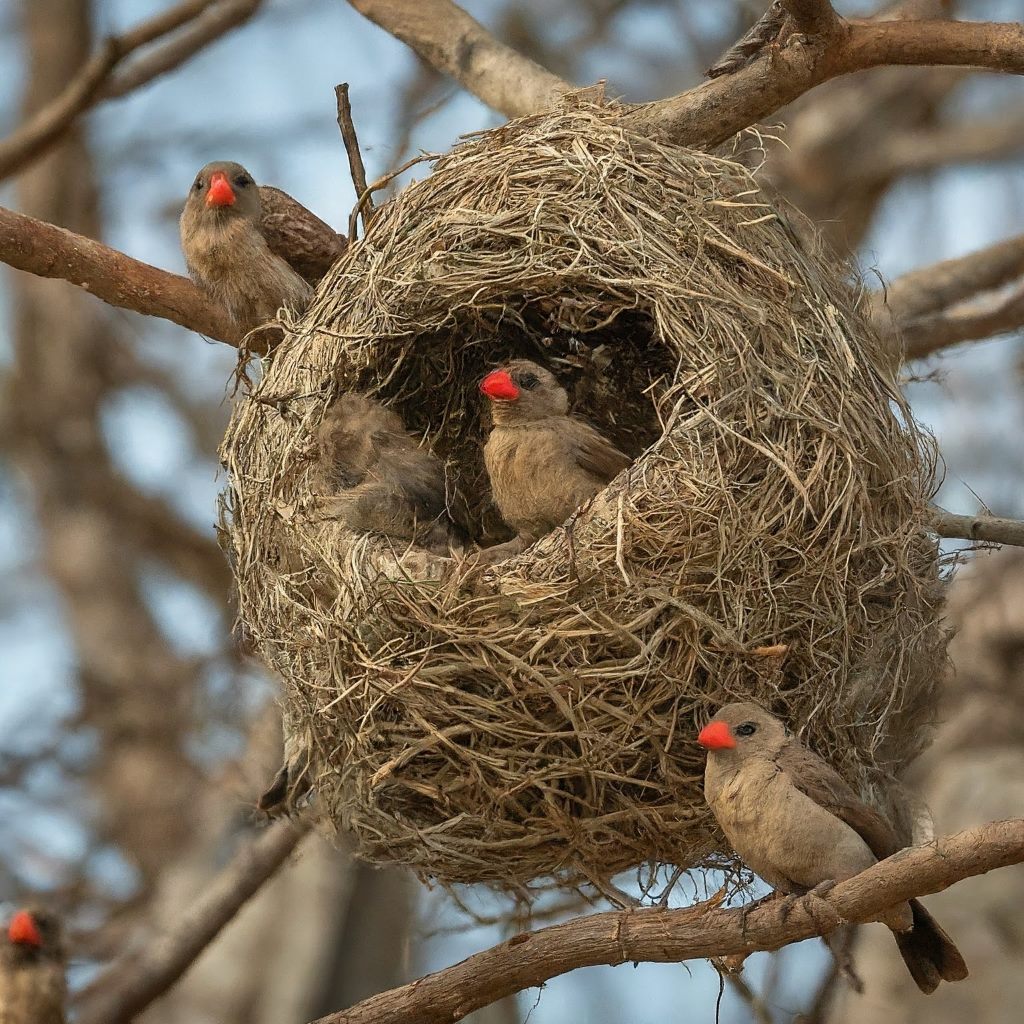
Red billed Buffalo Weaver
The Red-billed Buffalo Weaver (Bubalornis niger) is a striking bird found in sub-Saharan Africa, particularly in savannas, grasslands, and open woodlands. It belongs to the family Ploceidae and is characterized by its buff-colored plumage, bright red bill, and distinctive white markings on its wings and tail. The Red-billed Buffalo Weaver is named for its habit of nesting in large colonies, often on the backs of African buffalo or other large mammals. These birds are highly social and form complex societies, with multiple individuals contributing to the construction and maintenance of communal nests. Red-billed Buffalo Weavers feed primarily on insects, seeds, and grains, which they forage for on the ground or glean from vegetation. They are also known for their vocalizations, including loud calls and chattering sounds, which they use to communicate with each other and defend their territories.
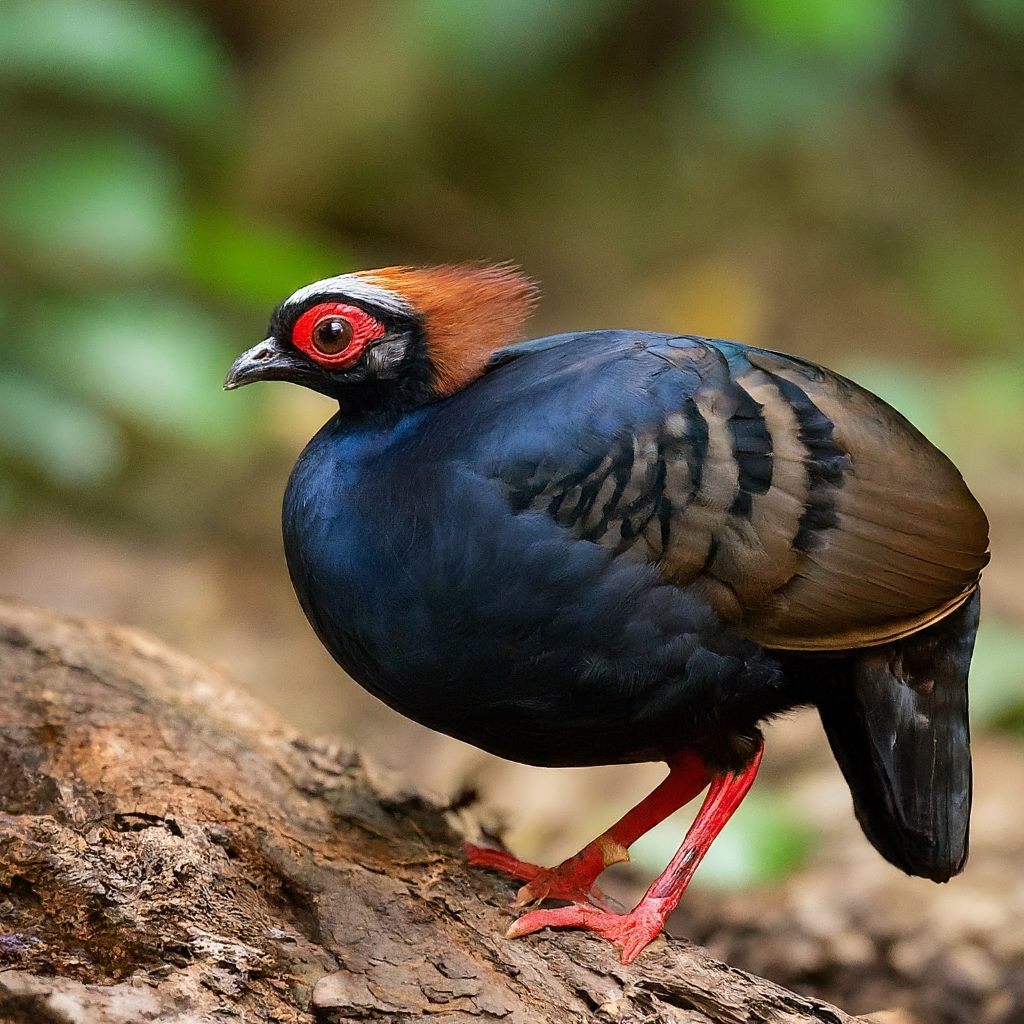
Red crested Wood Partridge
The Red-crested Wood Partridge (Rollulus rouloul) is a small bird found in the forests and woodlands of Southeast Asia, particularly in Indonesia, Malaysia, and Thailand. It belongs to the family Phasianidae and is characterized by its distinctive red crest, bright orange bill, and striking black and white plumage. The Red-crested Wood Partridge is often found in dense undergrowth and forest edges, where it forages for insects, seeds, and berries. These birds are known for their secretive behavior and are often difficult to observe in the wild. Red-crested Wood Partridges are monogamous birds and form long-term pair bonds, often staying together throughout the year to raise their chicks. They are also popular as pets and are often kept in captivity for their beautiful plumage and gentle disposition.
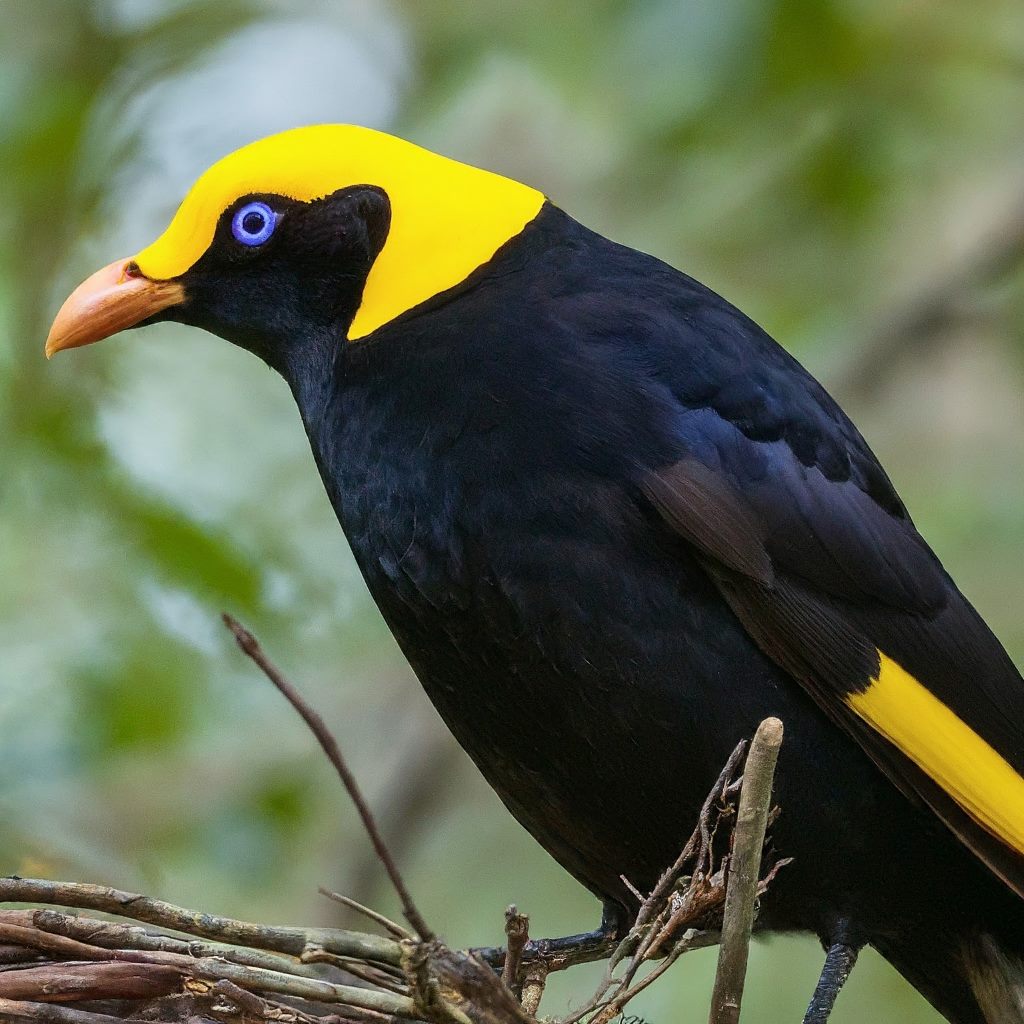
Regent Bowerbird
The Regent Bowerbird (Sericulus chrysocephalus) is a stunning bird found in the forests and woodlands of eastern Australia, particularly in New South Wales and Queensland. It belongs to the family Ptilonorhynchidae and is characterized by its glossy black plumage, bright orange-yellow crest, and striking blue-black eyes. The male Regent Bowerbird has a distinctive golden-yellow crown and throat, which contrasts with its black body and wings. These birds are known for their elaborate courtship displays, which involve building and decorating intricate bowers (avenues of sticks and grass) to attract females. Regent Bowerbirds are also talented mimics and often incorporate a variety of sounds and vocalizations into their courtship rituals. They feed primarily on fruits, berries, and insects found in the forest canopy, using their strong bills to crack open tough seeds and husks.
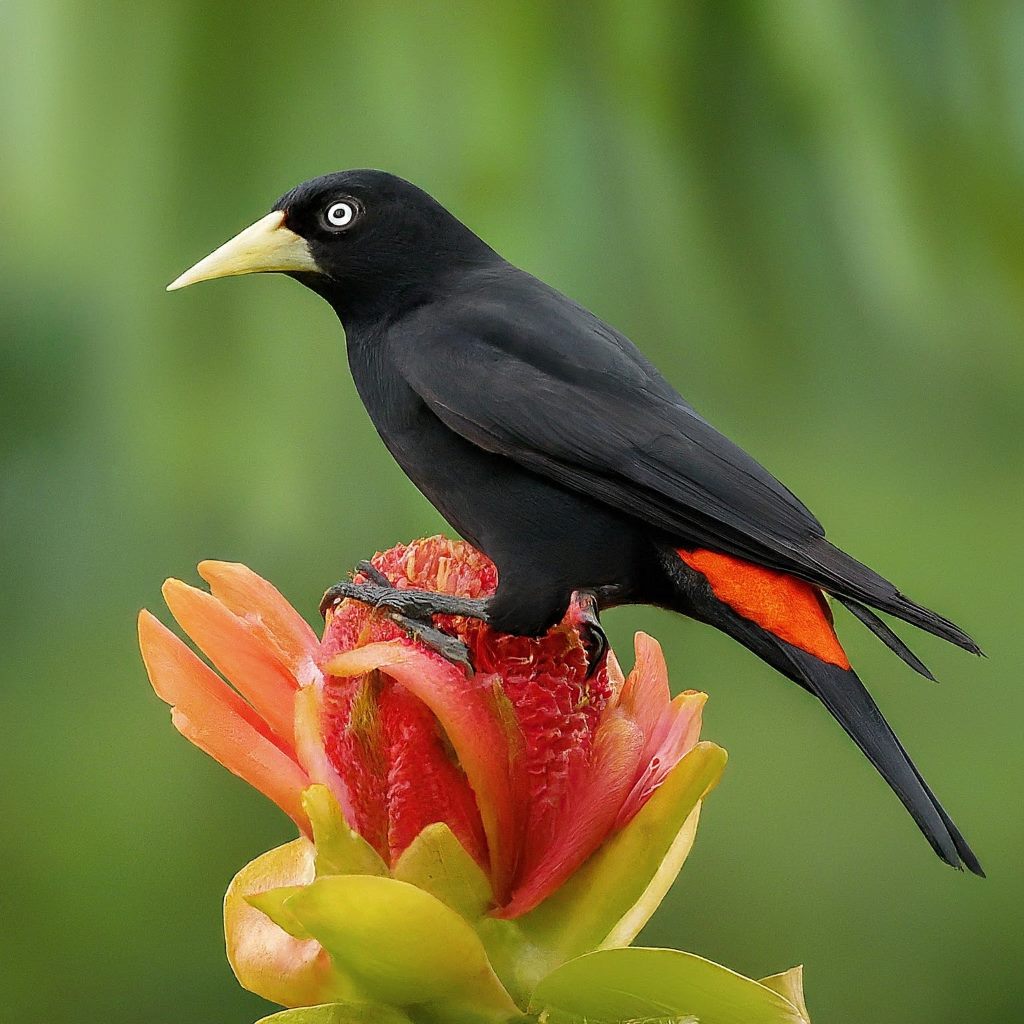
Scarlet rumped Cacique
The Scarlet-rumped Cacique (Cacicus uropygialis) is a striking bird found in Central and South America, particularly in the tropical forests of Mexico, Guatemala, and Honduras. It belongs to the family Icteridae and is characterized by its glossy black plumage, bright orange bill, and distinctive scarlet-red rump and undertail coverts. The Scarlet-rumped Cacique is often found in large colonies, nesting together in communal nests suspended from the branches of tall trees. These birds are highly social and form complex societies, with multiple individuals contributing to the construction and maintenance of communal nests. Scarlet-rumped Caciques feed primarily on fruits, berries, and insects found in the forest canopy, using their strong bills to crack open tough seeds and husks. They are also important seed dispersers and play a vital role in maintaining the health of tropical forest ecosystems.
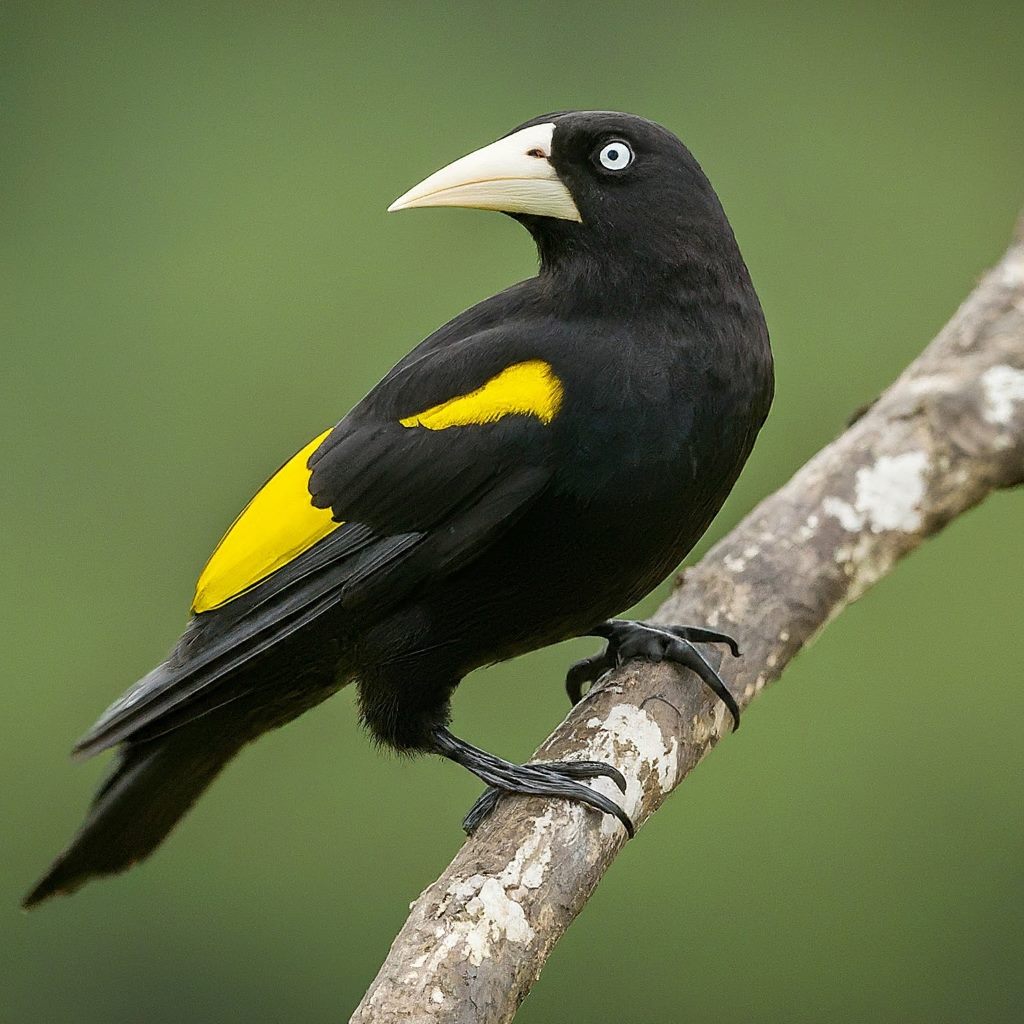
Yellow rumped Cacique
The Yellow-rumped Cacique (Cacicus cela) is a striking bird found in Central and South America, particularly in the tropical forests of Mexico, Guatemala, and Honduras. It belongs to the family Icteridae and is characterized by its glossy black plumage, bright orange bill, and distinctive yellow rump and undertail coverts. The Yellow-rumped Cacique is often found in large colonies, nesting together in communal nests suspended from the branches of tall trees. These birds are highly social and form complex societies, with multiple individuals contributing to the construction and maintenance of communal nests. Yellow-rumped Caciques feed primarily on fruits, berries, and insects found in the forest canopy, using their strong bills to crack open tough seeds and husks. They are important seed dispersers and play a vital role in maintaining the health of tropical forest ecosystems.
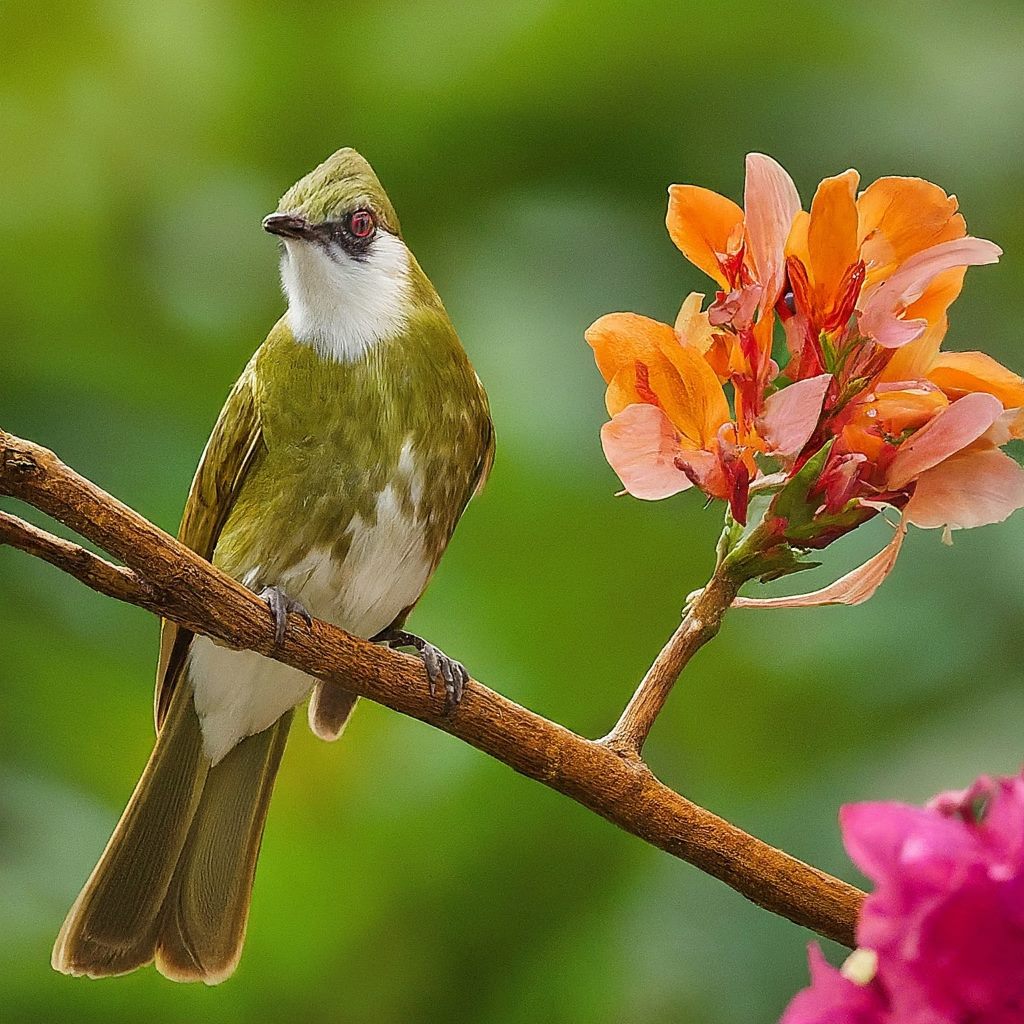
Seychelles Bulbul
The Seychelles Bulbul (Hypsipetes crassirostris) is a beautiful songbird found in the granitic islands of the Seychelles archipelago in the Indian Ocean. It belongs to the family Pycnonotidae and is characterized by its glossy black plumage, bright orange bill, and distinctive white belly and undertail coverts. The Seychelles Bulbul is often found in dense forests and woodlands, where it forages for insects, fruits, and berries. These birds are highly social and often form small flocks, hopping and flitting among the branches in search of food. Seychelles Bulbuls are also known for their melodious songs, which echo through the forest canopy during the breeding season. They are important seed dispersers and play a vital role in maintaining the health of island ecosystems.
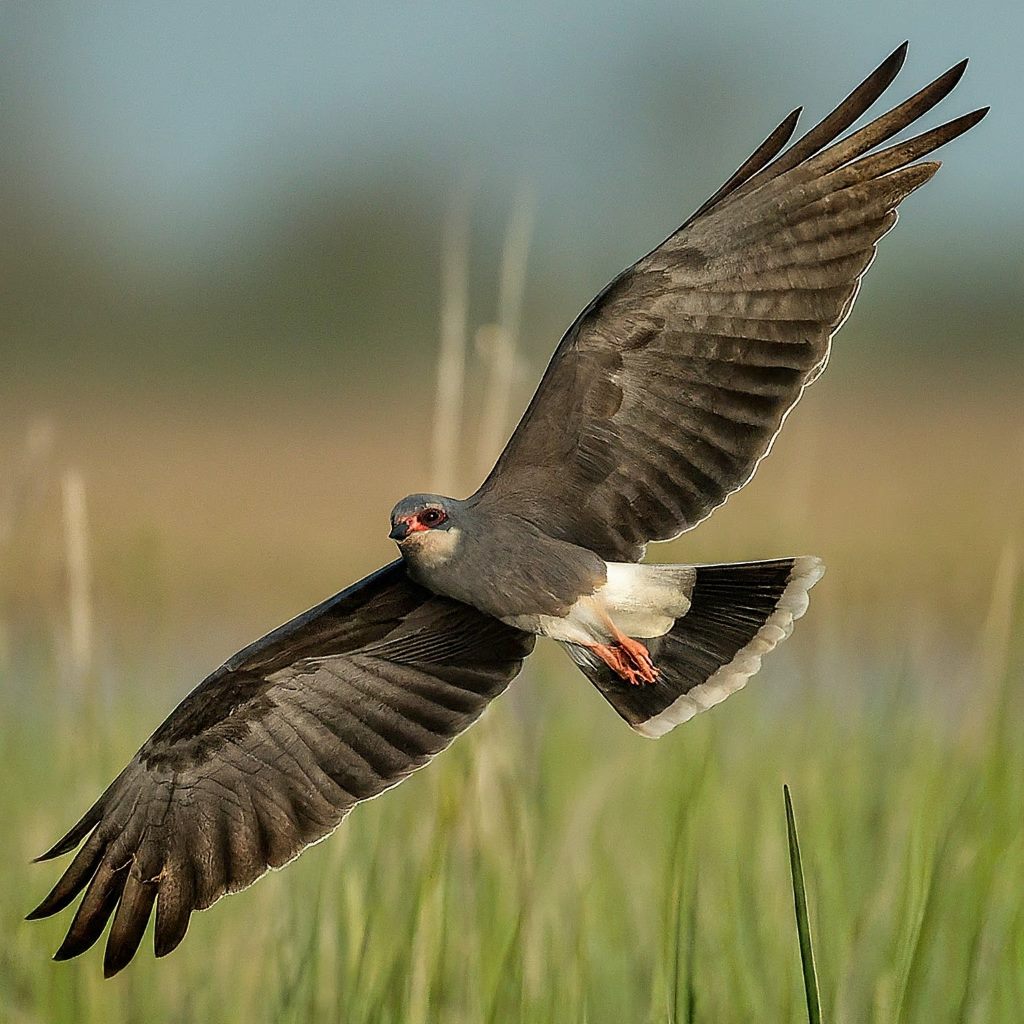
Snail Kite
The Snail Kite (Rostrhamus sociabilis) is a raptor found in the wetlands and marshes of the Americas, particularly in the southern United States, Central America, and northern South America. It belongs to the family Accipitridae and is characterized by its sleek black plumage, bright orange bill, and distinctive hooked beak. The Snail Kite has long, slender wings and a forked tail, which make it an agile flier and adept at catching prey in flight. These birds feed primarily on freshwater snails, which they extract from their shells using their sharp bill and talons. Snail Kites are often seen flying low over marshes and wetlands, scanning the water’s surface for signs of movement. They are also known for their vocalizations, including high-pitched whistles and trills, which they use to communicate with each other and defend their territories.
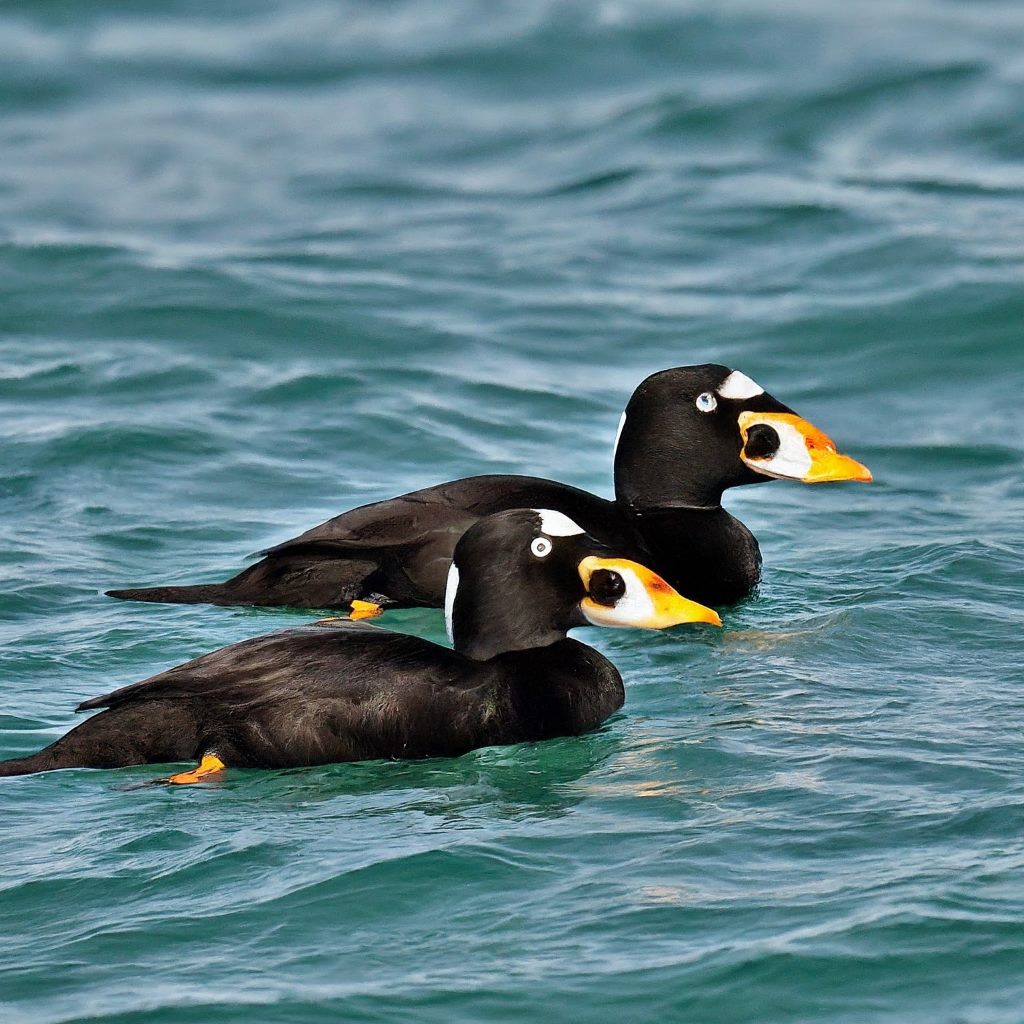
Surf Scoter
The Surf Scoter (Melanitta perspicillata) is a sea duck found along the coasts of North America, particularly in the Arctic and subarctic regions of Canada and Alaska. It belongs to the family Anatidae and is characterized by its striking black and white plumage, bright orange bill, and distinctive white patches on its forehead and nape. The Surf Scoter has a compact body with a short, stout bill, which it uses to catch a variety of prey, including mollusks, crustaceans, and small fish. These birds are often seen diving and swimming in open water, using their wings to propel themselves underwater in search of food. Surf Scoters are highly gregarious and often form large flocks during the winter months, migrating between their breeding and wintering grounds in search of food and suitable habitat.
Toco Toucan
The Toco Toucan (Ramphastos toco) is a striking bird found in the forests and woodlands of South America, particularly in Brazil, Argentina, and Paraguay. It belongs to the family Ramphastidae and is characterized by its large, colorful bill, bright orange throat, and striking black plumage with white markings on its breast and tail. The Toco Toucan has a long, slender bill with a serrated edge, which it uses to reach fruits, insects, and small vertebrates in the canopy of tall trees. These birds are often seen in small flocks, hopping and flitting among the branches in search of food. Toco Toucans are also known for their loud, croaking calls and vocalizations, which echo through the forest canopy during the breeding season. They are important seed dispersers and play a vital role in maintaining the health of tropical forest ecosystems.
Tufted Puffin
The Tufted Puffin (Fratercula cirrhata) is a seabird found in the North Pacific Ocean, particularly in the coastal waters of Alaska, Russia, and Japan. It belongs to the family Alcidae and is characterized by its distinctive black and white plumage, bright orange bill, and striking tufts of yellow feathers on its head and neck. The Tufted Puffin has a compact body with short wings and a stubby tail, ideal for diving and swimming underwater in search of prey. These birds feed primarily on small fish, crustaceans, and planktonic organisms, which they catch by plunge-diving from the air or diving beneath the surface of the water. Tufted Puffins are highly gregarious and often form large colonies during the breeding season, nesting on rocky cliffs and offshore islands. They are known for their raucous calls and social behaviors, including elaborate courtship displays and synchronized swimming.
Violet Turaco
The Violet Turaco (Musophaga violacea) is a stunning bird found in the forests and woodlands of West Africa, particularly in Guinea, Sierra Leone, and Liberia. It belongs to the family Musophagidae and is characterized by its glossy black plumage, bright orange bill, and striking violet-blue feathers on its wings and tail. The Violet Turaco has a loud, raucous call and is often heard before it is seen, announcing its presence in the forest canopy. These birds feed primarily on fruits, berries, and insects found in the forest canopy, using their strong bills to crack open tough seeds and husks. Violet Turacos are also important seed dispersers and play a vital role in maintaining the health of tropical forest ecosystems.
Wattled Curassow
The Wattled Curassow (Crax globulosa) is a large bird found in the forests and woodlands of South America, particularly in Colombia, Ecuador, and Peru. It belongs to the family Cracidae and is characterized by its glossy black plumage, bright orange bill, and distinctive red wattles (fleshy growths) on its throat and neck. The Wattled Curassow has a powerful bill and strong legs, which it uses to forage for fruits, seeds, and insects on the forest floor. These birds are often found in small family groups, foraging together in dense undergrowth and leaf litter. Wattled Curassows are also known for their loud, booming calls, which echo through the forest during the breeding season. They are important seed dispersers and play a vital role in maintaining the health of tropical forest ecosystems.
Conclusion
The glossy black plumage and bright orange beaks are not just ornamental features but serve important functions in their daily lives, from attracting mates and defending territories to capturing prey and communicating with other members of their species. By understanding and appreciating the natural history of these birds, we can gain a deeper insight into the complexities of the natural world and the interconnectedness of all living things.
As stewards of the environment, it is our responsibility to protect and conserve these magnificent creatures and the habitats they depend on for survival. By preserving their natural habitats, reducing pollution, and mitigating the impacts of climate change, we can ensure that future generations will continue to marvel at the beauty and diversity of birds with black plumage and orange beaks for years to come.

94% of pet owners say their animal pal makes them smile more than once a day. In 2007, I realized that I was made for saving Animals. My father is a Vet, and I think every pet deserves one. I started this blog, “InPetCare”, in 2019 with my father to enlighten a wider audience.
